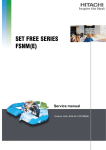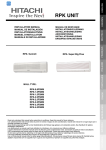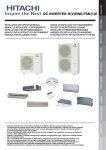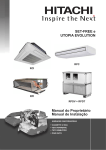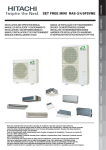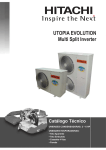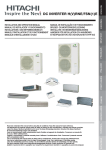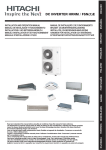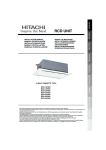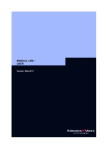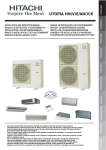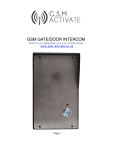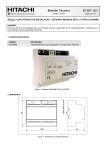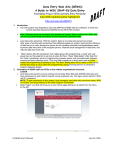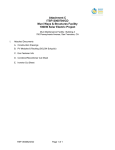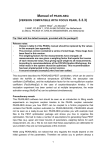Download UTOPIA RASC
Transcript
UTOPIA
RASC-G8 SERIES
Technical Catalog
Outdoor Units: 5, 10 HP
CONTENTS
0/1
0 CONTENTS
PART II INSTALLATION DATA
PART I TECHNICAL DATA
9
1 FEATURES AND BENEFITS
1.1. System description
1.2. Installation advantages
1/2
1/4
2 GENERAL DATA
2.1. General Data for RASC-5/10HG8E
2.2. Component data for RASC-5/10HG8E
2.3
Name of parts
2/2
2/3
2/4
3 DIMENSIONAL DATA
3.1. RASC-5HG8E
3.2. RASC-10HG8E
3/2
3/3
4 CAPACITIES AND SELECTION DATA
4.1. System Selection Procedure
4/2
4.2. Combinability
4/5
4.3. Standard Cooling and Heating capacity tables 4/5
4.4. Cooling Capacity table
4/6
4.5. Heating Capacity table
4/6
4.6. Correction Factors
4/7
4.7. Fan Performance Curve
4/9
4.8. Sound Data
4/10
4.9. Operation Space
4/11
5 WORKING RANGE
5.1. Power supply
5.2. Temperature Range
5.3. Refrigerant Piping Length
5/2
5/2
5/3
6 ELECTRICAL DATA
6.1. Electrical data for RASC-5/10-HG8E
6/2
7 ELECTRICAL WIRING DIAGRAMS
7.1. Electrical Wiring Diagrams
for RASC-5HG8E
7.2. Electrical Wiring Diagrams
for RASC-10HG8E
8 REFRIGERANT CYCLE
8.1. Refrigerant Cycle for RASC-5/10HG8E
7/3
7/4
8/1
REFRIGERANT PIPING AND REFRIGERANT
CHARGE
9.1
Piping Materials
9.2. Three principles on Refrigerant Piping Work
9.3. Suspension of Refrigerant Piping
9.4. Piping connection for RASC-5/10HG8E
9.5. Piping and Refrigerant Charge
9.6. Refrigerant Charging Quantity
9/2
9/3
9/4
9/4
9/5
9/12
10 DRAIN PIPING
10.1 Drain Piping RASC-5/10HG8E
10/2
11 ELECTRICAL WIRING
11.1. General Check
11.2. Electrical Wiring Connection
for RASC-5/10HG8E
11.3. Common Wiring
11/2
11/3
12 AVAILABLE OPTIONAL FUNCTIONS
12.1. RASC-5/10HG8E
Available Optional Functions
12/2
13 TROUBLESHOOTING
13.1. Alarm Codes
13/2
11/2
0/2
CONTENTS
Units Code List
NOTE:
MODELS CODIFICATION
Please check, according to the model name, which is your air conditioner type and how it is
abbreviated and refered to in this technical catalogue.
This Technical Catalogue provides data concerning to ducted G8 Outdoor Unit. For Indoor
Units data refer Technical Catalogue TCGB0033 Utopia G8.
For Installation, Operation and Maintenance data, refer to Service Manual SMGB0033
Utopia G8.
INDOOR UNIT (HP)
OUTDOOR UNIT
TWIN
TRIPLE
RAS-5HG8E
2.5/2.5
3.0/2.0
2.0/1.5/1.5
RAS-10HG8E
5.0/5.0
6.0/4.0
3.0/3.0/4.0
QUAD
2.5/2.5/2.5/2.5
! OUTDOOR UNIT
OUTDOOR UNIT
Heat Pump
Model
Code
RASC-5HG8E
70874441
RASC-10HG8E
70874443
3~
! Model Meaning for Outdoor Unit
RASC- 5 H G 8 E
Unit Type
C: Centrifugal
(Outdoor Unit)
RAS
Compressor Power (HP)
5-10
H: Heat Pump Series Number
Scroll Compressor R407C
Made in
Europe
CONTENTS
0/3
! INDOOR UNITS
INDOOR UNITS FSN(E/M)
4-Way-Cassette
2-Way-Cassette
Ceiling
In-The-Ceiling
Unit
Code
Unit
Code
Unit
Code
Unit
Code
RCI–1.5FSN1E
7E861619
RCD–1.5FSN
60277814
–
–
RPI–1.5FSNE
7E877304
RCI–2.0FSN1E
7E861621
RCD–2.0FSN
60277815
RPC–2.0FSNE
7E872055
RPI–2.0FSNE
7E872024
RCI–2.5FSN1E
7E861620
RCD–2.5FSN
60277816
RPC–2.5FSNE
7E872030
RPI–2.5FSNE
7E872025
RCI–3.0FSN1E
7E871770
RCD–3.0FSN
60277817
RPC–3.0FSNE
7E872058
RPI–3.0FSNE
7E872031
RCI–4.0FSN1E
7E871780
RCD–4.0FSN
60277818
RPC–4.0FSNE
7E872059
RPI–4.0FSNE
7E872032
RCI–5.0FSN1E
7E871790
RCD–5.0FSN
60277819
RPC–5.0FSNE
7E872060
RPI–5.0FSNE
7E872033
RCI–6.0FSN1E
7E871794
–
–
RPC–6.0FSNE
7E872061
RPI–6.0FSNE
7E872034
–
–
–
–
–
–
RPI-10HG7E
70786733
RCI
RCD
RPC
RPI
INDOOR UNITS FSN(E/1M)
Wall
Floor
Floor Concealed
Unit
Code
Unit
Code
Unit
Code
RPK–1.5FSN1M
60277867
–
–
–
–
RPK–1.5FSNM
60277825
RPF–1.5FSNE
7E877716
RPFI–1.5FSNE
7E877720
RPK–2.0FSNM
60277826
RPF–2.0FSNE
7E877309
RPFI–2.0FSNE
7E877311
RPK-2.5FSNM
60277844
RPF–2.5FSNE
7E877310
RPFI–2.5FSNE
7E877312
RPK-3-0FSNM
60277845
–
–
–
–
RPK-4-0FSNM
60277847
–
–
–
–
RPK
RPF
RPFI
! Model Meaning for Indoor Unit
RPI- 3.0 F S N (1) (E)
Unit Type
(Indoor Unit)
RCI - RCD RPC - RPI
RPK - RPF - RPF(I)
Compressor Power (HP)
1.5 - 2.0 - 2.5 - 3.0 - 4.0 - 5.0 - 6.0
N: R410A Series
Compatible
H-Link Set-Free / System
Free
E: Made in Europe
M: Made in Malaysia
–: Made in Japan
0/4
CONTENTS
COMPLEMENTARY SYSTEMS
Accessory
Name
Code
KPI-2521
Total Heat Exchanger
60277481
KPI-5021
Total Heat Exchanger
60277482
KPI-8021
Total Heat Exchanger
60277483
KPI-10021
Total Heat Exchanger
60277484
EF-5GE
Econofresh Kit
7E774148
Figure
ACCESSORIES CODE LIST
Accessory
Name
Code
D-2AVE
D-2HVE
D-10AVE
D-10HVE
Drier R407C
Drier R407C
Drier R407C
Drier R407C
7E799901
7E799902
7E799903
7E799904
PC-P1HE
Remote Control Switch
7E799954
PSC-5S
Central Station
60291050
PSC-5T
7 Day Timer
60291052
PC-P5H
Optional Remote Controller
60290879
Figure
CONTENTS
Accessory
Name
Code
Figure
PC-LH3A
Wireless Control Switch
60291056
PC-RLH11
Receiver Kit
(for RCI ,RCD, RPC, RPI, RPK,RPF(I)
– on the wall–)
60291109
PC-RLH8
Receiver kit
(for RCI-FSN1E –on the panel–)
60299961
PC-RLH9
Receiver Kit (2-Wires)
(for RCD –on the panel–)
60291107
PSC-5HR
H-LINK Relay
60291105
(not shown)
PCC 1A
Optional Function Connector
60199286
(not shown)
PRC-10E1
PRC-15E1
PRC-20E1
PRC-30E1
2P Extension Cord
2P-Extension Cord
2P-Extension Cord
2P-Extension Cord
7E790211
7E790212
7E790213
7E790214
THM-R2AE
Remote Sensor (THM4)
7E799907
HARC-BXE (A)
HARC-BXE (B)
Interface
60290874
60290875
CS-NET
(HARC-40E)
CS-NET + Interface
6E191922
DBS-26
Drain Discharging Boss
60299192
0/5
0/6
CONTENTS
Accesory
Name
Code
P-G23WA2
Air Panel
60290534
P-G23DWA1
Air Panel
60299570
P-G46DWA1
Air Panel
60299571
TE-56
Distributors
6E200002
TE-10
Distributors
7E700004
TRE-06
Distributors
7E700005
TRE-10
Distributors
7E700008
QE-810
Distributors
7E700006
B-23H4
Adopter for deodorant filter
60199790
F-23L4-K
F-23L4-D
Anti bacteria filter
Deodorant filter
60199791
60199793
F-46L4-D
Deodorant filter
60199794
PDF-23C3
Duct connection flange
60199795
PDF-46C3
Duct connection flange
60199796
OACI-232
Fresh air intake kit
60199797
PD-75
Fresh air intake kit
60199798
PI-23LS5
3 Way outlet parts
60199799
PSP-23W3
Space panel for replace 4-6HP
60199800
TKCI-232
T duct connecting kit
60199801
Figure
(not shown)
FEATURES AND BENEFITS
1/1
1 FEATURES AND BENEFITS
This chapter describes the features and benefits of the new Hitachi G8 series outdoor unit, which through its system flexibility
and modularity will provide you with the complete solution for your building air conditioning requirements.
CONTENTS
1
1.1.
FEATURES AND BENEFITS ________________________________________________ 1
System description ________________________________________________________ 2
1.1.1.
1.1.2.
1.2.
General overview __________________________________________________________ 2
Combination flexibility ______________________________________________________ 2
Installation advantages _____________________________________________________ 4
1.2.1.
1.2.2.
Electrical wiring ___________________________________________________________ 4
Easy service and commissioning______________________________________________ 4
1/2
FEATURES AND BENEFITS
1.1. System description
To help you quickly discover all the features and benefits of the
system, this section provides an overview of the system, the
choice of compatible indoor units, a description of the various
unit combinations, and details concerning the benefits of the
electronic expansion valve that the system uses.
1.1.1.
General overview
Hitachi is proud to announce the introduction of the new
UTOPIA G8 series outdoor unit with its combination of
SYSTEM FREE indoor units. This combination allows the
interconnection of the same indoor units in all the systems.
In achieving this Hitachi has effectively started a NEW
GENERATION of AIR CONDITIONING.
Outdoor Unit
Indoor Unit
SET FREE FSG(1)/FXG(1)/FSN/FXN
FSN(1)E
R410A/
R407C
DC INVERTER HVRG/HVRNE
UTOPIA G8, RAS/ RASC
The system provides effortless selection, easy control, logical zoning, and trouble-free installation. Through its modularity the
system delivers maximum flexibility and consequently offers increased benefits for both customers and installers.
1.1.2.
Combination flexibility
With its modular design the new Utopia RASC-5/10 G8
series outdoor unit provides a totally flexible air
conditioning solution. This offers not only standard cooling
functions but, in addition, heating (for Heat Pump models),
dry and fan operation for all environments.
Twin, Triple and Quad configurations are suitable for large
standard-shaped room areas. These combinations deliver
air conditioning from several units to obtain a smooth and
even airflow. This would be very difficult to achieve using a
single standard large-sized unit.
The systems are offered in the following combinations:
! Single, twin, triple and quad with the Centrifugal
UTOPIA outdoor unit
Examples of the various combinations:
Single with Centrifugal Utopia Unit
Twin with Centrifugal Utopia Unit
FEATURES AND BENEFITS
Triple with Centrifugal Utopia Unit
1/3
Quad with Centrifugal Utopia Unit
" Compatibility
According to the table on the right, the compatibility
between different systems remains as it follows:
! The New Outdoor Units G8 Series will be accepted with
the Set Free Indoor Units (System Free).
Compatibility Indoor and Outdoor Unit
UTOPIA
Outdoor
! The connection between Utopia Outdoor Units G8
Series and Utopia Indoor Units G7 Series is accepted.
! The connection between Utopia Outdoor Units G8
Series and Utopia Indoor Units G5 Series is not
accepted.
Indoor
HG7E
(Cool/Heat Unify)
RASC-HG8E
FSG2E/FSG2Ei/
FSN(1)E
FEATURES AND BENEFITS
1/4
1.2. Installation advantages
This section details the enhancements that have been
made to the new UTOPIA RASC G8 series outdoor units to
simplify their installation.
1.2.2.
Easy service and commissioning
To provide more efficient sevicing and comissioning the
systems are equipped with on-board test, trial operation,
and self-diagnosis functions.
" Test run
- An automatic test run function is available to aid
commissioning using the outdoor unit dip switch or the
indoor unit remote control switch.
- The system is equipped with an identification system
" Location
This unit can be installed in indoor or outdoor locations.
Usually is used in some places that is impossible to
place the outdoor unit outside the building.
" Carefree maintenance
Easy maintenance access is assured without the need
to move or disconnect any of the outdoor units thanks to
the conveniently located front access panel.
" Operational to -8ºC
The outdoor heat pump temperature, can be safely and
effectively operated in external temperatures as low as
-8°C.
1.2.1.
Electrical wiring
The electrical control wiring is greatly simplified through the
use of the H-LINK wiring system.
" H-Link system
The H-LINK wiring system requires only two
transmission wires for connecting each outdoor unit to
its indoor units (to control up to 16 refrigerant cycles).
Both outdoor units and indoor units require connecting
wires in series.
The H-LINK system provides the following advantages:
- Trouble-free and adaptable installation.
- No polarity requirements.
- Freely combinable.
- CS-Net connection via indoor or outdoor unit
- Up to 64 indoor units
- Up to cable run length: 1000 m
Example of H-LINK system
Outdoor
Unit
Transmission
Wires
Indoor Unit
Refrigerant
Piping
Indoor Units
CS-NET
that can be used to confirm which series the connected
outdoor units are members of (for example: single or
multi). This is controlled with a remote control switch.
- An automatic address coding system is also provided.
This automatically gives a unit number to individual
Indoor Units (Indoor Units can also be manually
allocated with a unit number using their rotary type dip
switches).
" Trial operation and self diagnosis
The new remote control switch provides highly efficient
control functions. A new self-diagnosis function, which
enables quick checking of operation conditions in the
Indoor Units and Outdoor Unit, has been implemented.
Furthermore, alarm data can be stored in the memory of
an on-board microcomputer when an abnormality
occurs.
- Data memory in the remote control switch
If an abnormality occurs, the remote control switch
LCD will indicate an alarm code so that quick diagnosis
is available at the site.
- Optional function setting by remote control switch
Cancellation of a 4 degree shift in heating mode or fan
speed increasing setting, are set via Remote Control
Switch.
Then, multiple Indoor Units can be set, at the same
time.The configuration can also be easily changed,
even after installation is completed.
" Service checker
A Service Checker to monitor installation conditions and
the operational status of air conditioning systems
through a desktop or laptop-type computer is available.
You can also easily create test run records (A service
checker system consists of a special interface unit and a
field-supplied desktop computer).
GENERAL DATA
2 GENERAL DATA
For Indoor Units data refer to TCGB0033 about Hitachi Utopia G8 Series.
CONTENTS
2
GENERAL DATA _________________________________________________________ 1
2.1.
General Data for RASC-5/10HG8E____________________________________________ 2
2.2
Component data for RASC-5/10HG8E _________________________________________ 3
2.3.
Name of parts ____________________________________________________________ 4
2.3.1.
2.3.2.
RASC-5HG8E ____________________________________________________________ 4
RASC-10HG8E ___________________________________________________________ 4
2/1
2/2
GENERAL DATA
2.1. GENERAL DATA FOR RASC-5/10HG8E
Model RASC
Nominal Cooling Capacity
Nominal Heating Capacity
Cabinet Colour
Sound Pressure Level (1*)
Height
Outer Dimensions
Width
Depth
Net Weight
Refrigerant Charge
kW
kW
dB (A)
mm
mm
mm
Kg
Kg
Refrigerant
Type
Model
Quantity
Type
Fan Motor
Output
Quantity
Nominal Static Pressure
Maximum Static Pressure
Compressor
W
mmAq
mmAq
Connections
Liquid Line
Gas Line
Drain Piping (Outer diameter)
Packing Measurements
Refrigerant Piping
mm (in)
mm (in)
mm
3
m
RASC-5HG8E
RASC-10HG8E
12.50
14.00
Soft Grey (RAL 9002)
53
555
1312
835
175
4.5
R407C (Factory Charged
for 10 meters) (2*)
Hermetic (Scroll)
G500DH
1
Centrifugal Fan
550
1
5
13
Service Valves with Flare Nut
connection
9.53 (3/8)
19.05 (3/4)
22
0.60
25.00
28.00
Soft Grey (RAL 9002)
60
640
2050
928
310
4.5
R407C (Factory Charged
for 10 meters) (2*)
Hermetic (Scroll)
G1000EL
1
Centrifugal Fan
1100
1
5
13
Service Valves with Flare Nut
connection/ Flange connection
15.88 (5/8)
28.6 (1 1/8)
22 (two locations)
0.88
NOTE:
(1*)
. The Sound Pressure Level is based on following
conditions:
AVAILABLE POWER SUPPLY VOLTAGES:
The available voltages for the different units are shown in the
following table.
- 3 m from the unit front surface
The above data was measured in an anechoic chamber
so that reflected sound should be taken into
consideration in the field.
In case of Night Shift conditions, the noise level
decreases about 2 dB (A)
(2*)
. The outdoor unit is charged with refrigerant before
shipment. The charged volume is the equivalent of a
refrigerant piping of 10 meters, when combining to
HITACHI standard indoor unit.
Model
Voltage (V)
Power Supply
Phase
Frequency (Hz)
RASC-5HG8E
380-415
3
50
RASC-10HG8E
380-415
3
50
GENERAL DATA
2.2. COMPONENT DATA FOR RASC-5/10HG8E
Compressor
Fan Unit
Heat Exchanger
Model RAS
Heat Exchanger Type
Material
Tube
Outer Diameter
Rows
Material
Fin
Pitch
Frontal Area
Maximum Operating Pressure
Number of Heat Exchanger/Unit
Type
Number/Unit
Outer Diameter
Fan
Revolutions
Nominal Air Flow/Fan
Type
Starting Method
Fan
Nominal Output
Motor
Quantity
Insulation Class
Model
Revolutions 50Hz
Displacement 50Hz
Capacity Steps
Air Tight Pressure Discharge
Motor
Type
Oil
Starting Method
Poles
Insulation
Type
Charge
Units
mm
mm
m2
Kg/cm2 G
MPa
mm
rpm
m³/min
kW
rpm
mm
Kg/cm² G
MPa
liters
RASC-5HG8E
Multi-Pass Cross Finned Tube
Copper Tube
9.53
5
Aluminium
2
0,52
33.0
3.30
1
Centrifugal Fan
1
320
950
60
Drip-Proof Type Enclosure
Permanent Split Capacitor
0,55
1
B
G500 DH-80D1
2880
13,82
0-100
33.0
3.30
Direct-on-line Starting
2
E
Ether Oil IDEMUTSU FVB68D
1,8
RASC-10HG8E
Multi-Pass Cross Finned Tube
Copper Tube
9.53
5
Aluminium
2
0,87
33.0
3.30
1
Centrifugal Fan
1
320
875
98
Drip-Proof Type Enclosure
Permanent Split Capacitor
1,10
1
F
G1000EL-160D3
2880
13,82
0 – 100
33.0
3.30
Direct-on-Line Starting
2
E
3.5
2/3
2/4
GENERAL DATA
2.3. NAME OF PARTS
2.3.1.
2.3.2.
RASC-5HG8E
No.
1
2
3
4
5
6
7
8
9
10
11
12
13
14
15
16
17
18
19
20
21
22
23
24
25
26
27
Part Name
Fan
Fan Motor
Heat Exchanger
Capillary tube for Gas By-pass
Strainer
Electric Control Box
Compressor
Check Valve
Reversing Valve
Stop Valve for Gas Line
Stop Valve for Liquid Line
Accumulator
Check Joint
Solenoid Valve for Gas By-pass
High-Pressure Switch
Pressure Switch
Oil Heater
Vibration Isolation Rubber
Protector Net
Drain Pipe
Stop Valve Protector
Drain Pan
Drain Pipe Protector
Cycle Service Panel
Air Inlet Panel
Air Outlet Panel
Fan Service Panel
No.
1
2
3
4
5
6
7
8
9
10
11
12
13
14
15
16
17
18
19
20
21
22
23
24
25
26
27
Part Name
Fan
Fan Motor
Heat Exchanger
Capillary tube for Gas By-pass
Strainer
Electrical Box
Compressor
Header
4-Way Valve
Stop Valve for Gas Line
Stop Valve for Liquid Line
Accumulator
Check Joint
Solenoid Valve for Gas By-pass
High-Pressure Switch
Pressure Switch
Oil Heater
Vibration Isolation Rubber
Protector Net
Drain Pipe
Stop Valve Protector
Drain Pan
Drain Pipe Protector
Service Panel
Air Inlet Panel
Air Outlet Panel
Fan Service Panel
RASC-10HG8E
DIMENSIONAL DATA
3. DIMENSIONAL DATA
For Indoor Units data refer to TCGB0033 about Hitachi Utopia G8 Series.
CONTENTS
3. DIMENSIONAL DATA ___________________________________________________________ 1
3.1. RASC–5HG8E________________________________________________________________ 2
3.2. RASC–10HG8E_______________________________________________________________ 3
3/1
3/2
DIMENSIONAL DATA
3.1. RASC–5HG8E
Mark Name
1
2
3
4
5
6
7
8
9
10
11
Air Inlet
Air Outlet
Refrigerant Gas Line
Refrigerant Liquid Line
Valve Protector
Drain Pipe Protection
Drain Pipe
Service Panel
Holes for Wiring connection
Alternatie Air Inlet
Alternative Air Outlet
Remarks
19.05 Flange
9.53 Flare Nut
Electrical Box Access
DIMENSIONAL DATA
3.2. RASC–10HG8E
Mark Name
1
2
3
4
5
6
7
8
9
10
11
Air Inlet
Air Outlet
Refrigerant Gas Line
Refrigerant Liquid Line
Valve Protector
Drain Pipe Protection
Drain Pipe
Service Panel
Holes for Wiring connection
Alternative Air Inlet
Alternative Air Outlet
Remarks
28.6 Flange
15.88 Flare Nut
Electrical Box Access
3/3
CAPACITIES AND SELECTION DATA
4/1
4 CAPACITIES AND SELECTION DATA
This chapter is a guide for selecting the most suitable units for your requirements and shows you the performance details of
each unit.
CONTENTS
4
CAPACITIES AND SELECTION DATA ________________________________________ 1
4.1.
System Selection Procedure_________________________________________________ 2
4.1.1.
4.1.2.
4.1.3.
How to use the data from the chapter __________________________________________ 2
Selection Example for Cooling Load ___________________________________________ 2
Selection Example, Heating Load _____________________________________________ 4
4.2.
Combinability_____________________________________________________________ 5
4.3.
Standard Cooling and Heating capacity tables ___________________________________ 5
4.4.
Cooling Capacity table _____________________________________________________ 6
4.5.
Heating Capacity table _____________________________________________________ 6
4.6.
Correction Factors_________________________________________________________ 7
4.6.1.
4.6.2.
Correction Factors Due to piping length ________________________________________ 7
Sensible Heat Factor _______________________________________________________ 8
4.7.
Fan Performance Curve ____________________________________________________ 9
4.8.
Sound Data _____________________________________________________________ 10
4.9.
Operation Space _________________________________________________________ 10
4/2
CAPACITIES AND SELECTION DATA
4.1. SYSTEM SELECTION PROCEDURE
This chapter shows how to select a suitable model for
certain requirements.
4.1.1.
HOW TO USE THE DATA FROM THE
CHAPTER
When your requirements are defined (load, working
temperatures and installation requirements) is necessary to
select the most suitable units.
To calculate the suitable units use the following information:
From chapter 4:
! Combinability from subchapter 4.2
! Cooling capacity data from subchapter 4.4
! Heating capacity data from subchapter 4.5
! Piping length and lift correction factor from subchapter
4.6
! Sensible heat factor from subchapter 4.6.2
! Noise data from subchapter 4.8
! Operation Space from subchapter 4.9
Use also the following data:
! General data from Chapter 2
! Electrical Data from Chapter 6
Outdoor Unit could be installed using ducts at Inlet and
Outlet air. The fan performance for duct calculation should
be considered, as Subchapter 4.7. shows.
Next examples of selection unit for Cooling Load and
Heating Load will use the following units type, selected after
consider above indications.
4.1.2.
SELECTION EXAMPLE FOR COOLING
LOAD
In order to show how to select the units characteristics, we
define the following requirements:
Step 0: System requirements
Cooling load:
Total cooling load:
Sensible heat load:
Outdoor Air inlet Dry Bulb temperature:
Indoor Air inlet Dry Bulb Temperature:
Indoor Air inlet Wet Bulb Temperature:
10.5 kW
8.0 kW
35.0 ºC
26.0 ºC
18.0 ºC
Installation restrictions:
Power source: 380 V, 3~, 50 Hz.
Outdoor unit under indoor unit: 15.0 meters.
Piping Length: 27.0 meters
Indoor units type:
In this case Twin system with an RPK-FSNM and
RPC-FSNE indoor units is required.
Step 1: Select outdoor unit capacity performance
Pre-select an outdoor unit according to required the cooling
load at defined temperatures (outdoor air inlet dry Bulb and
indoor air inlet wet bulb). Selected unit must have a bigger
cooling capacity than the cooling capacity required.
Use cooling capacity data from subchapter 4.4.
CR
RASC-5HG8E
0,61
Outdoor
Air Inlet
DB (°C)
Indoor air inlet web bulb (°C) /
dry bulb (°C)
16/23
18/25
CAP
IPTo/u
CAP
IPTo/u
10
12,77 4,68
13,62
4,16
15
12,40 4,31
13,23
4,39
21
12,25 4,57
13,13
4,67
25
12,13 4,81
12,88
4,91
30
11,75 5,00
12,50
5,14
35
11,38 5,24
12,13
5,33
40
10,75 5,53
11,50
5,67
Table 1 -Cooling Capacity DataApply a correction factor according to piping length and lift
(subchapter 4.6) to the cooling capacity
System cooling capacity = cooling capacity x
correction factor = 12,13 x 0,9 = 10,91 kW
We conclude that the most suitable Outdoor unit for the
system requirements is RASC-5HG8E.
CAPACITIES AND SELECTION DATA
4/3
Step 2: Indoor unit capacity performance
Select the indoor units according to your specific
requirements. In this case Twin system using a RPK and
RPC unit is required. See combinability from subchapter 4.2
for allowed indoor units.
In this case outdoor unit selected (step 1) is a
RASC-5HG8E (allows to be combined with RPK-3.0FSNM
and RPC-2.0FSNE indoor units).
where
SHCc corrected sensible heat capacity (kW).
SHC sensible heat capacity (kW).
CR correction ratio (from subchapter 4.4).
DBr evaporator dry bulb temp (ºC).
DB evaporator dry bulb temp (ºC) or interpolated for each
WB in the table.
Once outdoor unit and indoor units have been selected is
necessary to adjust the indoor unit nominal capacity to the
system.
For the example system:
A. Outdoor unit fix the system cooling capacity.
SHCcRPC = 3,22 + 0,61x(26-25) = 3,83 kW
SHCcRPK = 4,62 + 0,61x(26-25) = 5,23 kW
B. Get, for each indoor unit, the nominal capacity from
chapter 2 in TCGB0033.
C. Define indoor unit capacity distribution for each unit
based on total system indoor unit capacity.
D. To calculate indoor unit capacity apply the indoor unit
distribution ratios to the system cooling capacity.
RASC5HG8E
Use cooling capacity data from subchapter 4.4. to get
outdoor unit input at required temperatures.
cooling capacity
nominal capacity
10,91 kW
5,0 kW
C
distribution
=5,0/(5,0+7,1) =7,1/(5,0+7,1)
7,1 kW
=0,41
=0,59
unit performance
=10,91x0,41
=10,91x0,59
capacity
=4,47kW
=6,43kW
10,91 kW
SHCc = 9,06 kW
Step 4: IPT calculation
B
SYSTEM CAPACITY
SHCc = SHCcRPC + SHCcRPK = 3,83 + 5,23 =9,06
RPC-2.0FSNE RPK-3.0FSNM
A
D
System sensible heat capacity is:
4,47 kW
6,43 kW
Step 3: Sensible heat capacity (SHC)
System requirements specify a sensible heat load equal to
8kW. When unit performance capacity is defined is possible
to calculate sensible heat capacity for each indoor unit.
From subchapter 4.6.2 get Sensible heat factor SHF for high
fan speed.
CR
RASC-5HG8E 0.61
Indoor air inlet web bulb (ºC) /
dry bulb (ºC)
Outdoor Air
16/23
18/25
Inlet DB (ºC)
CAP IPTo/u CAP IPTo/u
10
12,77
4,08
13,62
4,16
30
11,75
5,00
12,50
5,14
35
11,38
5,24
12,13
5,33
40
10,75
5,53
11,50
5,67
Table 2 -Cooling Capacity dataGet indoor unit input from chapter 6 Electrical data.
IPT = IPTo/u + Σ IPTi/u
IPT= IPTo/u + IPTRPC + IPTRPK = 5,33 + 0,14 + 0,09 =5,56
IPT =5,56 kW
Calculate sensible heat corrected factor for all indoor units
using the formula:
Step 5: EER calculation
SHC = unit performance capacity x SHF
To calculate EER use the following formula:
SHCRPC = 4,47 x 0,72 = 3,22 kW
SHCRPK = 6,43 x 0,72 = 4,62 kW
EER = Cooling capacity / IPT
EER = 10,91 / 5,56 = 1,96
Difference between system required indoor air inlet dry bulb
temperature (26 °C) and cooling capacity data indoor air
inlet dry bulb temperature (25º) makes necessary to adjust
the sensible heat corrected for each indoor unit. Use the
following formula:
EER =1,96
SHCc =SHC + CR x (DBr – DB)
CAPACITIES AND SELECTION DATA
4/4
4.1.3.
SELECTION EXAMPLE, HEATING LOAD
In order to show how to select system units characteristics,
we define the following requirements:
Step 0: System requirements
Heating load:
Total heating load:
Outdoor Air inlet Wet Bulb Temperature:
Indoor Air inlet Dry Bulb Temperature:
A. Outdoor unit fix the system cooling capacity.
B. Get, for each indoor unit, the nominal capacity from
chapter 2 in TCGB0033.
C. Define indoor unit capacity distribution for each unit
based on total system indoor unit capacity.
D. To calculate indoor unit capacity apply the indoor unit
distribution ratios to the system cooling capacity.
11 kW
0ºC
18ºC
RASC5HG8E
Installation restrictions:
Power source: 380 V, 3~, 50 Hz.
Outdoor unit under indoor unit: 15.0 metres.
Piping Length: 27.0 meters
Indoor units type:
In this case Twin system with an RPK-FSNM and RPCFSNE indoor units is required.
Step 1: Select outdoor unit capacity performance
Pre-select an outdoor unit according to required the heating
load at defined temperatures (outdoor air inlet and indoor air
inlet wet bulb). Selected unit must have a bigger heating
capacity than the heating capacity required.
A
cooling capacity
B
nominal capacity
5,60 kW
C
distribution
=5,6/(5,6+8,0) =8,0/(5,6+8,0)
D
RASC5HG8E
8,82
4,66
8,95
4,61
-5
10,36
4,59
10,50
4,54
0
11,76
4,87
11,90
4,78
5
13,30
5,20
13,44
5,11
10
14,70
5,49
14,84
5,44
15
16,24
5,82
16,38
5,77
Table 3 -Heating Capacity dataApply a correction factor according to piping length and lift
(subchapter 4.6) to the heating capacity.
System heating capacity = heating capacity x
correction factor = 11.90 x 1.0 = 11.90 kW
We conclude that the most suitable Outdoor unit for the
system requirements is RASC-5HG8E.
Step 2: Indoor unit performance capacity
Select the indoor units according to your specific
requirements. In this case Twin system using a RPK and
RPC unit is required. See combinability from subchapter 4.2
for allowed indoor units.
In this case outdoor unit selected (step 1) is an RAS-5HG8E
(allows to be combined with RPK-3.0FSNM and RPC2.0FSNE indoor units).
Once outdoor unit and indoor units have been selected is
necessary to adjust the indoor unit nominal capacity to the
system.
8,00 kW
=0,59
unit performance
=11,90x0,41
=11,90x0,59
capacity
=4,88kW
=7,02kW
4,88 kW
7,02 kW
SYSTEM CAPACITY
11,90 kW
Step 3: IPT calculation
Use heating capacity data from subchapter 4.4. to get
outdoor unit input at required temperatures.
Indoor air inlet dry bulb (ºC)
16
18
CAP
IPT o/u
CAP
IPT o/u
-7
11,90 kW
=0,41
Use heating capacity data from subchapter 4.5.
Outdoor
Air Inlet
WB (ºC)
RPC-2.0FSNE RPK-3.0FSNM
RASC-5HG8E
Indoor air inlet cry bulb (ºC)
Outdoor
Air Inlet
WB (ºC)
CAP
IPT o/u
CAP
-7
8,82
4,66
8,95
4,61
-5
10,36
4,59
10,50
4,54
0
11,76
4,87
11,90
4,78
16
18
IPT o/u
5
13,30
5,20
13,44
5,11
10
14,70
5,49
14,84
5,44
15
16,24
5,82
16,38
5,77
Table 4 -Heating capacity dataGet indoor unit input from chapter 6 Electrical data.
IPT = IPTo/u + Σ IPTI/U
IPT= IPTo/u + IPTRPC + IPTRPK = 4,78 + 0,14 + 0,09 = 5,01
IPT= 5,01 kW
Step 4: EER calculation
To calculate EER use the following formula:
EER = Heating capacity / IPT
EER = 11,90 / 5,01 = 2,37
EER = 2,37
CAPACITIES AND SELECTION DATA
4/5
4.2. COMBINABILITY
The new UTOPIA Centrifugal G8 series, allows increase the
flexibility of installation. It allows the connection between the
different types and horse power Indoor Units with the same
Outdoor Units.
The differents possible combinations are indicated in the
table below
Indoor Units possible Combinations
Outdoor
Unit
Combinations
Single
RASC5HG8E
RCI-2.5
RCD-2.5
RPC-2.5
RPI-2.5
RPK-2.5
RPF-2.5
RPFI-2.5
-
RCI-3.0
RCD-3.0
RPC-3.0
RPI-3.0
RPK-3.0
RCI-3.5
RPC-3.5
RPI-3.5
RPK-3.5
RCI-4.0
RCD-4.0
RPC-4.0
RPI-4.0
RCI-5.0
RCD-5.0
RPC-5.0
RPI-5.0
RCI-6.0
RPC-6.0
RPI-6.0
RPI-8
RPI-10
-
-
-
1
-
-
-
-
2
-
-
-
-
-
-
-
-
1
-
1
-
-
-
-
-
-
Triple
2
1
-
-
-
-
-
-
-
-
Single
-
-
-
-
-
-
-
-
-
1
-
-
-
-
-
-
2
-
-
-
-
-
-
-
-
1
-
1
-
-
Twin
-
RCI-2.0
RCD-2.0
RPC-2.0
RPI-2.0
RPK-2.0
RPF-2.0
RPFI-2.0
-
-
Twin
RASC10HG8E
RCI-1.5
RCD-1.5
RPI-1.5
RPK-1.5
RPF-1.5
RPFI-1.5
Triple
-
-
-
2
-
1
-
-
-
-
Quad
-
-
4
-
-
-
-
-
-
-
NOTE:
RPF(I):can not be connected with another unit in twin, triple or quad combination
4.3. STANDARD COOLING AND HEATING CAPACITY TABLES
Outdoor Unit
Type
RASC-5HG8E
Cooling+
Heating
RASC-10HG8E
Cooling+
Heating
Indoor Unit
RCI-5.0FSN1E
RPC-5.0FSNE
RPI-5.0FSNE
RCD-5.0FSN
RPI-10HG7E
RCI-5.0FSN1Ex2
RPC-5.0FSNEx2
RPI-5.0FSNEx2
RCD-5.0FSNx2
Input
Power
[kW]
(Cooling)
5,57
5,66
5,66
5,61
11,21
11,13
11,31
11,31
11,23
Cooling
Output
[kW]
EER
12,50
12,50
12,50
12,50
25,00
25,00
25,00
25,00
25,00
2,24
2,21
2,21
2,23
2,23
2,25
2,21
2,21
2,23
NOTE:
Defrost factor is included
The nominal cooling and heating capacity is the combined capacity
of the HITACHI standard split system, and are based on the
ISO13253 for RPI Type and ISO 5151 for the rest of the models.
Operation
Cooling
Conditions
27.0 °C DB
Indoor Air Inlet
Temperature
19.0 °C WB
35.0 °C DB
Outdoor Air Inlet
Temperature
Piping Length: 7.5 meters
DB: Dry Bulb; WB: Wet Bulb
Heating
20.0 °C DB
7.0 °C DB
6.0 °C WB
For more information about capacities, see Chapter 4.4.
Cooling
Input Power
Performance [kW] (Heat)
Performance
Class
A
B
C
D
E
F
G
5,20
5,29
5,29
5,26
9,86
9,78
9,96
9,96
9,88
Heat Output
[kW]
COP
14,00
14,00
14,00
14,00
28,00
28,00
28,00
28,00
28,00
2,69
2,65
2,65
2,66
2,84
2,86
2,81
2,81
2,83
Heating
Performance
Multi-split conditioner
Cooling
Heating
3.20 < EER
3.60 < COP
3.20 ≥ EER > 3.00
3.60 ≥ COP > 3.40
3.00 ≥ EER > 2.80
3.40 ≥ COP > 3.20
2.80 ≥ EER > 2.60
3.20 ≥ COP > 2.80
2.60 ≥ EER > 2.40
2.80 ≥ COP > 2.60
2.40 ≥ EER > 2.20
2.60 ≥ COP > 2.40
2.20 ≥ EER
2.40 ≥ COP
4/6
CAPACITIES AND SELECTION DATA
4.4. COOLING CAPACITY TABLE
CR
RASC-5HG8E
0,61
RASC-10HG8E
0,61
Outdoor
Unit Inlet
air
DB (ºC)
10
15
21
25
30
35
40
10
15
21
25
30
35
40
Indoor Unit Inlet air WET BULB temperature (ºC) / DRY BULB temperature (ºC)
16/23
Capacity
12,77
12,40
12,25
12,13
11,75
11,38
10,75
25,50
24,68
23,69
23,03
22,20
21,38
20,55
18/25
Capacity
13,62
13,23
13,13
12,88
12,50
12,13
11,50
27,25
26,38
25,33
24,63
23,75
22,88
22,00
IPTo/u
4,08
4,31
4,57
4,81
5,00
5,24
5,53
7,97
8,45
9,02
9,53
9,93
10,44
11,05
20/27
Capacity
14,32
13,93
13,88
13,63
13,13
12,88
12,25
28,75
27,84
26,74
26,01
25,10
24,19
23,28
IPTo/u
4,16
4,39
4,67
4,91
5,14
5,33
5,67
8,14
8,63
9,22
9,73
10,24
10,65
11,36
22/30
Capacity
14,83
14,44
14,38
14,13
13,75
13,38
12,75
29,75
28,88
27,83
27,13
26,25
25,38
24,50
IPTo/u
4,27
4,50
4,76
5,00
5,24
5,48
5,72
8,38
8,86
9,43
9,93
10,44
10,95
11,46
IPTo/u
4,39
4,61
4,86
5,14
5,33
5,53
5,86
8,63
9,10
9,63
10,24
10,65
11,05
11,77
CR: Correction ratio
IPTO/U:Input power of outdoor unit (indoor unit input power can be read on chapter 6)
4.5. HEATING CAPACITY TABLE
RASC-5HG8E
RASC-10HG8E
Indoor Unit Inlet air DRY BULB temperature (ºC)
Outdoor
Unit Inlet
air
WB (ºC)
Capacity
IPT o/u
Capacity
IPT o/u
Capacity
IPT o/u
Capacity
IPT o/u
Capacity
IPT o/u
-7
-5
0
5
10
15
-7
-5
0
5
10
15
8,82
10,36
11,76
13,30
14,70
16,24
17,64
18,70
21,36
24,02
26,68
29,34
4,66
4,59
4,87
5,20
5,49
5,82
8,76
8,61
9,14
9,77
10,30
10,92
8,95
10,50
11,90
13,44
14,84
16,38
17,92
18,98
21,64
24,30
26,96
29,62
4,61
4,54
4,78
5,11
5,44
5,77
8,66
8,52
8,97
9,59
10,21
10,84
8,95
10,64
12,04
13,58
14,98
16,52
18,00
19,07
21,73
24,39
27,05
29,71
4,46
4,40
4,73
5,01
5,34
5,58
8,38
8,25
8,88
9,41
10,03
10,48
9,07
10,78
12,18
13,72
15,12
16,66
18,28
19,35
22,01
24,67
27,33
29,99
4,41
4,26
4,59
4,97
5,25
5,53
8,28
7,99
8,61
9,32
9,86
10,39
9,20
10,78
12,32
13,72
15,26
16,80
18,56
19,63
22,29
24,95
27,61
30,27
4,31
4,21
4,54
4,82
5,20
5,44
8,10
7,90
8,52
9,05
9,77
10,21
16
18
20
22
IPTO/U:Input power of outdoor unit (indoor unit input power can be read on chapter 6)
NOTE:
Defrost factor is included.
24
26
Capacit
y
9,32
10,92
12,46
13,86
15,40
16,80
18,84
19,91
22,57
25,23
27,89
30,55
IPT o/u
4,21
4,16
4,44
4,78
5,06
5,39
7,91
7,81
8,34
8,97
9,50
10,12
CAPACITIES AND SELECTION DATA
4/7
4.6. CORRECTION FACTORS
4.6.1.
CORRECTION FACTORS DUE TO PIPING LENGTH
Correction Factor is based on the equivalent piping length in
meters (EL) and the vertical distance between Indoor and
Outdoor Unit in meters (H).
Outdoor Unit in sun roof
H:
Vertical Distance between Indoor Unit and Outdoor
Unit in Meter (m).
NOTE:
H
EL (case of twin,
triple or quad: the
longest)
EL
H
Indoor Unit(s) in floor
-H
EL (case of twin,
triple or quad: the
longest)
H>0: Position of Outdoor Unit is higher than
Position of Indoor Unit (m).
H<0: Position of Outdoor Unit is lower than Position
of Indoor Unit (m).
EL: Equivalent Total Distance between Indoor Unit and
Outdoor Unit in Meter (Equivalent one-way Piping
Length L (m)).
EL
-H
Outdoor Unit in basement
NOTE:
One 90° elbow is equivalent to 0.5m.
One 180° bend is equivalent to 1.5m.
One distributor branch is the equivalent to 0,5 m
For twin, Triple and Quad connection:
L= the longest distance.
" For cooling capacity
" For Heating Capacity
The cooling capacity should be corrected according the
following formula:
The heating capacity should be corrected according to the
following formula:
TCA= Capacity x F
TCA: Actual Corrected Cooling Capacity (kW).
Capacity:Cooling Capacity in the Cooling Capacity
table (kW).
F:
Correction Factor based on the Equivalent
Piping Length (in %).
THA= Capacityx F
THA: Actual Corrected Heating Capacity (kW)
Capacity:Heating Capacity in the Performance table
(kW)
F:
Correction Factor Based on the equivalent
Piping Length (in %).
4/8
4.6.2.
CAPACITIES AND SELECTION DATA
SENSIBLE HEAT FACTOR
The sensible heat factor of Indoor Units at each fan speed (Hi, Me, Lo) based on the JIS Standard B8616, is given below:
Indoor Unit Model
RCI-1.5FSN1E
RCI-2.0FSN1E
RCI-2.5FSN1E
RCI-3.0FSN1E
RCI-4.0FSN1E
RCI-5.0FSN1E
RCI-6.0FSN1E
RCD-1.5FSN
RCD-2.0FSN
RCD-2.5FSN
RCD-3.0FSN
RCD-4.0FSN
RCD-5.0FSN
RPC-2.0FSNE
RPC-2.5FSNE
RPC-3.0FSNE
RPC-4.0FSNE
RPC-5.0FSNE
RPC-6.0FSNE
RPK-1.5FSN1M
RPK-0.8FSNM
RPK-1.0FSNM
RPK-1.5FSNM
RPK-2.0FSNM
RPK-2.5FSNM
RPK-3.0FSNM
RPK-4.0FSNM
RPI-0.8FSNE
RPI-1.5FSNE
RPI-2.0FSNE
RPI-2.5FSNE
RPI-3.0FSNE
RPI-4.0FSNE
RPI-5-0FSNE
RPI-6.0FSNE
RPF-1.5FSNE
RPF-2.0FSNE
RPF-2.5FSNE
RPFI-1.5FSNE
RPFI-2.0FSNE
RPFI-2.5FSNE
SHF
Hi
0.77
0.78
0.73
0.79
0.78
0.74
0.73
0.73
0.75
0.74
0.74
0.73
0.69
0.72
0.72
0.72
0.72
0.72
0.72
0.73
0.73
0.73
0.73
0.72
0.72
0.72
0.72
0.81
0.73
0.76
0.76
0.75
0.73
0.72
0.72
0.73
0.73
0.73
0.73
0.73
0.73
Me
0.75
0.76
0.71
0.76
0.75
0.70
0.69
0.69
0.67
0.67
0.67
0.67
0.67
0.70
0.70
0.70
0.70
0.70
0.70
0.72
0.72
0.72
0.72
0.72
0.72
0.71
0.71
0.69
0.69
0.75
0.74
0.71
0.71
0.68
0.69
0.69
0.69
0.69
0.69
0.69
0.69
Lo
0.73
0.75
0.69
0.72
0.72
0.68
0.68
0.66
0.65
0.65
0.65
0.65
0.65
0.67
0.67
0.67
0.67
0.67
0.67
0.70
0.70
0.70
0.70
0.70
0.70
0.70
0.70
0.69
0.65
0.74
0.72
0.67
0.65
0.64
0.67
0.65
0.65
0.65
0.65
0.65
0.65
CAPACITIES AND SELECTION DATA
4/9
4.7. FAN PERFORMANCE CURVE
Outdoor unit could be installed using ducts at inlet and
outlet air.
Refer to fan performance curve, in order to ensure that the
air volume is within working range.
It’s assumed that unit will be installed using supply and
return air ducts. Find below fan performance curve to
decide which ducts are suitable
RASC-10HG8E
External Static Pressure (mm Aq)
External Static Pressure (mm Aq)
RASC-5HG8E
Air flow (m³/min)
• Nominal Point
NOTE:
- When design a duct, check to ensure that the Air
volume is within working range as indicate “Fan
Performance Curve”
- If the Air volume is set outside working range, watercarry-over (drop in the ceiling or into the room), noise
increases, fan motor damaged (high temperature),
insufficient Cooling/Heating capacity, phenomena can
occur.
- Therefore design ducts and select the correct fan
speed in order to keep the unit running in the
accepted working range selected.
Air flow (m³/min)
• Nominal Point
" Specific installation comment for RASC-5HG8E:
- It’s recommended to set up ducting work in order to
keep static pressure around 10mmAq. If measuring
static pressure or airflow is not available, measuring
ampers can give and idea of working point. As a
reference, at Pst = 0mmAq is 5.4 A, and at
Pst = 10mmAq is 4.65 A approximately (only
approximated since motor temperature, voltage will
affect Amps measurement).
If installation requires short and straight ducts (Pst
≤3mmAq) installation, whistle air sound could appear.
in order to avoid this situation it’s advisable to close
suction air inlet on outdoor unit (half of suction air inlet
closed, for example)
4/10 CAPACITIES AND SELECTION DATA
4.8. SOUND DATA
Model: RASC-10HG8E
3 Meter from the unit front surface
Octave Sound Pressure (dB: Overall C Scale)
Measurement point:
Power supply: 400V 50Hz
Measurement point:
Power supply: 400V 50Hz
3 Meter from the unit front surface
Noise Criteria Curve
Noise Criteria Curve
Nominal: 53 dBA
Nominal: 60 dbA
Octave Sound Pressure (dB: Overall C Scale)
Model: RASC-5HG8E
Frequency (Hz)
Frequency (Hz)
4.9. OPERATION SPACE
NOTE:
For more information about operation space see the
Chapter – Units Installation.
WORKING RANGE
5 WORKING RANGE
For Indoor Units data refer to TCGB0033 about HITACHI UTOPIA G8 Series.
CONTENTS
5
WORKING RANGE________________________________________________________ 1
5.1.
Power supply_____________________________________________________________ 2
5.2.
Temperature Range _______________________________________________________ 2
5.3.
Refrigerant Piping Length ___________________________________________________ 3
5/1
5/2
WORKING RANGE
5.1. POWER SUPPLY
Working Voltage
90% to 110% of the
Rated Voltage
Voltage Imbalance
Within a 3% Deviation
from Each Voltage at the
Main Terminal of
Outdoor Unit
Starting Voltage
Higher than 85% of the
Rated Voltage
Following the Council Directive 89/336/EEC and its amendments 92/31/EEC and 93/68/EEC, relating to electromagnetic
compatibility, next table indicates maximum permissible system impedance Zmax at the interface point of the user’s supply, in
accordance with EN61000-3-11.
MODEL
Zsource (Ω)
RASC-5HG8E
0.21
RASC-10HG8E
0.12
5.2. TEMPERATURE RANGE
Indoor
Temperature
Outdoor
Temperature
Cooling Operation
Heating Operation
Minimum
21 ºC DB / 15.5 ºC WB
15ºC DB
Maximum
32 ºC DB / 22.5 ºC WB
27ºC DB
Minimum
-5 ºC DB
-8 ºC WB
Maximum
43 ºC DB
15.5 ºC WB
Heating Operation
Cooling Operation
Oudoor Air
Dry Bulb
Temperature
(°C DB)
Outdoor Air
Wet Bulb
Temperature
(°C WB)
Indoor suction air Wet Bulb
Temperature (°C WB)
Indoor suction air Dry bulb
Temperature (°C DB)
NOTE:
- If the RASC-10 unit Ducts are designed for working over 9mmAq. External Static Pressure, cooling operation in shadowed
area (*1) is out of working range.
- In the case of combining the RASC-10 unit with a RPI-10HP unit, design indoor Ducts for working over 15mmAq. External
Static Pressure (do not use indoor unit High Static Pressure setting), otherwise cooling operation in shadowed area (*1) is
out of working range.
WORKING RANGE
5.3. REFRIGERANT PIPING LENGTH
Outdoor Unit
higher than
Indoor Unit
The refrigerant piping length
between the Indoor Unit and
the Outdoor Unit must be
designed according to Chapter
9.5.1
The graphic indicates the
maximum distances in height
(H) and length (L) between
Indoor and Outdoor Units
according to the Outdoor Unit
Power.
Outdoor Unit
lower than
Indoor Unit
Distance between Indoor and Outdoor Units
5/3
ELECTRICAL DATA
6
ELECTRICAL DATA
For Indoor Units data refer to TCGB0033 about Hitachi Utopia G8 Series.
CONTENTS
6
ELECTRICAL DATA _______________________________________________________ 1
6.1.
Electrical data for RASC-5/10-HG8E __________________________________________ 2
6/1
6/2
ELECTRICAL DATA
6.1. ELECTRICAL DATA FOR RASC-5/10-HG8E
Unit Main Power
Applicable
Voltage
Model
U
RASC5HG8E
RASC10HG8E
U:
Hz:
STC:
RNCc:
RNCF:
IPTc:
IPTF:
PH:
400
PH
3
HZ
50
Max.
457
Min.
342
Supply Voltage (V)
Frequency (Hz)
Starting Current (A)
Running Current Compressor (A)
Running Current Fan (A)
Input Power Compressor (kW)
Input Power Fan (kW)
Phase ( )
Outdoor Fan
Motor
Compressor Motor
PH
STC
Cooling
Operation
Heating
Operation
RNCFF IPTFF
Maximum
Current
Cool
(A)
Heat
(A)
RNCC
IPTCC
RNCC
IPTCC
67
7.8
4.63
7.3
4.36
5.7
0.86
10.5
9.9
109
17.3
9.82
13.3
7.52
6.3
1.20
23.4
17.9
3
NOTE:
This data is based on the same conditions as the
nominal capacity conditions. Refer to the notes of the
Unit General Data.
Specifications in these tables are subject to change
without notice in order that HITACHI may bring the
latest innovations to their customers.
ELECTRICAL WIRING DIAGRAMS
7 ELECTRICAL WIRING DIAGRAMS
For Indoor Units data refer to TCGB0033 about Hitachi UTOPIA G8 Series.
CONTENTS
7
ELECTRICAL WIRING DIAGRAMS ___________________________________________ 1
7.1
Electrical Wiring Diagram for RASC-5HG8E_____________________________________ 3
7.2
Electrical Wiring Diagrams for RASC-10HG8E ___________________________________ 4
7/1
Arrangement of Electric Parts
in Electrical Control Box
Electrical Control Box
(White)
(Black)
(Red)
Arrangement of Electric Parts
in Electrical Control Box
NOTE: All the field wiring equipment must comply with local codes
Main
Switch
For 240 V
7.1. ELECTRICAL WIRING DIAGRAM FOR RASC-5HG8E
Air
Location of connectors on PCB
For 220 V
Pipe
Comp
Solenoid Valve for Gas By-pass
Terminal Board
Transformer
Thermistor for Outdoor Unit
Thermistor for piping
Thermistor for Upper Part of Compressor
Auxiliary Relay for Compressor
Auxiliary Relay for Heater
Auxiliary Relay for Reversing valve Relay
Auxiliary Relay for Solenoid Valve
Magnetic and thermal circuit Breaker
Terminals
Closed-end Connector
Field Supplied
Field Wiring
Earth Wiring
Factory Wiring
SV
TB
TF
THM7
THM8
THM9
Y52C
YCH
Y21
Y20
MT
—··—··
––––––
-————
R
RVR
MC
NF1
MOF 1
PCB
PS(C)
PS(H)
PSW
Part Name
Capacitor for Outdoor Fan
Crankcase Heater
Contactor for Compressor Motor
Connector
Inserting Type Connector
Test Operation an Option Function Settings
Factory Fixed Settings
Capacity Settings
Refrigerant Cycle no. Settings
Transmitting Settings
Fuses
Internal Thermostat for Outdoor Fan Motor
Alarm Code LEDs -See subchapter 9.2.1LEDs
Motor Compressor
Noise Filter
Motor for Outdoor Fan
Printed circuit board
Pressure Switch (Control)
Pressure Switch (High)
Unconditional Defrosting Dwitch (Push
Switch)
Resistor
Reversing valve Relay
Mark
CA 1
CH
CMC
CN 20∼22
DS 1,2
DSW1
DSW2
DSW3
DSW4
DSW5
EF 1,2
ITO 1
LED 1∼4
DC Coil
DC Coil
DC Coil
DC Coil
Heat Pump
Only
On PCB
Built in MOF 1
4-bits
On PCB
On PCB
On PCB
On PCB
On PCB
Remarks
ELECTRICAL WIRING DIAGRAMS
7/3
Setting Position of Dip Switch DSW1, DSW2, DSW3, DSW4 and DSW5
NOTE: All the field wiring equipment must comply with local codes
Arrangement of Electric Parts
in Electrical Control Box
Location of connectors on PCB
7.2. ELECTRICAL WIRING DIAGRAM FOR RASC-10HG8E
Arrangement of Electric Parts
in Electrical Control Box
Solenoid Valve for Gas By-pass
Terminal Board
Transformer
Thermistor for Outdoor Unit
Thermistor for piping
Thermistor for Upper Part of Compressor
Auxiliary Relay for Compressor
Auxiliary Relay for Heater
Auxiliary Relay for Reversing valve Relay
Auxiliary Relay for Solenoid Valve
Magnetic and thermal circuit Breaker
Terminals
Closed-end Connector
Field Supplied
Field Wiring
Earth Wiring
Factory Wiring
SV
TB
TF
THM7
THM8
THM9
Y52C
YCH
Y21
Y20
MT
—··—··
––––––
-————
R
RVR
MC
NF1
MOF 1
PCB
PS(C)
PS(H)
PSW
Part Name
Capacitor for Outdoor Fan
Crankcase Heater
Contactor for Compressor Motor
Connector
Inserting Type Connector
Test Operation an Option Function Settings
Factory Fixed Settings
Capacity Settings
Refrigerant Cycle no. Settings
Transmitting Settings
Fuses
Internal Thermostat for Outdoor Fan Motor
Alarm Code LEDs -See subchapter 9.2.1LEDs
Motor Compressor
Noise Filter
Motor for Outdoor Fan
Printed circuit board
Pressure Switch (Control)
Pressure Switch (High)
Unconditional Defrosting Dwitch (Push
Switch)
Resistor
Reversing valve Relay
Mark
CA 1
CH
CMC
CN 20∼22
DS 1,2
DSW1
DSW2
DSW3
DSW4
DSW5
EF 1,2
ITO 1
LED 1∼4
DC Coil
DC Coil
DC Coil
DC Coil
Heat Pump
Only
On PCB
Built in MOF 1
4-bits
On PCB
On PCB
On PCB
On PCB
On PCB
Remarks
7/4
ELECTRICAL WIRING DIAGRAMS
REFRIGERANT CYCLE
8/1
8 REFRIGERANT CYCLE
This chapter describes the Refrigerant Cycle and shows the main parts of the system for the possible configurations of the new
Hitachi UTOPIA G8 Series.
CONTENTS
8
REFRIGERANT CYCLE ____________________________________________________ 1
8.1.
Refrigerant Cycle RASC-5/10HG8E ___________________________________________ 2
8/2
REFRIGERANT CYCLE
8.1. REFRIGERANT CYCLE RASC-5/10HG8E
! SINGLE UNIT
Outdoor Unit:
RASC-5HG8E
Indoor Unit:
RPI-5.0FSNE
(Field supplied)
! TWIN UNITS
Outdoor Unit:
RASC-10HG8E
Indoor Unit:
RCI-5FSN1E
(Field supplied)
Indoor Unit:
RCI-5FSN1E
Refrigerant Flow Direction (Cooling)
Refrigerant Flow Direction (Heating)
Field Refrigerant Piping
Flare Connection
Flange Connection
No.
1
2
3
4
5
6
7
8
9
10
Part Name
Compressor
Indoor Heat Exchanger
Outdoor Heat Exchanger
Accumulator
Expansion valve
Reversing Valve
Distributor
Check Joint
Pressure Switch (High)
Pressure Switch (Gas Bypass)
No.
11
12
13
14
15
16
17
18
19
Part Name
Restrictor
Stop Valve (Gas Line)
Stop Valve (Liquid Line)
Solenoid Valve (Gas Bypass)
Capillary Tube (Gas Bypass)
Strainer
Filter dryer (Field Spplied)
Ball Valve (Field Supplied)
Branch Pipe
REFRIGERANT PIPING AND REFRIGERANT CHARGE
9/1
9 REFRIGERANT PIPING AND REFRIGERANT CHARGE
This chapter describes the way to connect and to change the refrigerant quantity in the system. For Indoor Units data refer to
TCGB0033 about Hitachi Utopia G8 Series.
CONTENTS
9
REFRIGERANT PIPING AND REFRIGERANT CHARGE __________________________ 1
9.1.
Piping Materials___________________________________________________________ 2
9.2.
Three principles on Refrigerant Piping Work ____________________________________ 3
9.3.
Suspension of Refrigerant Piping _____________________________________________ 4
9.4.
Piping connection for RASC-5/10HG8E ________________________________________ 4
9.5.
Piping and Refrigerant Charge _______________________________________________ 5
9.5.1.
9.5.2.
9.5.3.
9.5.4.
9.5.5.
9.5.6.
9.5.7.
9.5.8.
9.5.9.
9.5.10.
9.6.
Refrigerant Piping Length ___________________________________________________ 5
Refrigerant Piping Selection__________________________________________________ 5
Twin, Triple and Quad System Installation ______________________________________ 6
Branch Pipes _____________________________________________________________ 7
Tightening Flare Nuts_______________________________________________________ 8
Brazing Work _____________________________________________________________ 8
Flushing Refrigerant Pipes___________________________________________________ 9
Air Tight Presure Test ______________________________________________________ 9
Vacuum Drying___________________________________________________________ 10
Refrigerant Charge Procedure _______________________________________________ 11
Refrigerant Charging Quantity ______________________________________________ 12
9.6.1.
9.6.2.
Single System ___________________________________________________________ 12
Twin, Triple and Quad System_______________________________________________ 12
9/2
REFRIGERANT PIPING AND REFRIGERANT CHARGE
9.1. PIPING MATERIALS
1. Prepare locally-supplied copper pipes.
2. Select the piping size with the correct thickness and
correct material which can have sufficient pressure
strength, considering that R407C pressure is higher than
R22. The sub-chapter 10.13 shows the required pipe.
3. Select clean copper pipes. Make sure there is not dust
and moisture inside. Blow the inside of the pipes with
oxygen free nitrogen to remove any dust and foreign
materials before connecting pipes.
4. After connecting the refrigerant piping, seal the open
space between Knockout hole and refrigerant pipes by
using insulation material as shown bellow:
5. It is recomended Insulate the unions and flare-nuts at the
piping connections completely. Cover the liquid piping
and gas piping with field-supplied thermal insulator
completely to avoid decreasing of performance and
dewing on the surface of the pipe.
NOTE:
A system with no moisture or oil contamination will
give maximum performance and lifecycle compared to
that of a poorly prepared system. Take particular care
to ensure all copper piping is clean and dry internally.
CAUTION:
- Cap the end of the pipe when pipe is to be inserted
through a hole
- Do not put pipes on the ground directly without a cap
or vinyl tape at the end of the pipe
Correct
Incorrect
Insulation material
Field-Supplied
Refrigeration Pipe
Unit
Side
Insulation material
Insulation material
- If piping installation is not completed until next day or
over a longer period of time, braze off the ends of the
piping and charge with oxygen free nitrogen through a
Schrader valve type access fitting to prevent moisture
and particle contamination.
- Do not use insulation material that contents NH3
because can damage cooper pipe material and can be
a source of future leakage
REFRIGERANT PIPING AND REFRIGERANT CHARGE
9/3
9.2. THREE PRINCIPLES ON REFRIGERANT PIPING WORK
In case of the refrigeration cycle with new refrigerant
R407C, refrigeration oil should be of synthetic type.
Therefore, the oil absorbs moisture quickly when compared
with R22 systems and it will cause sludge and oxidation of
the oil.
Three Principles
Cause of failure
Water Infiltration due to insufficient
1. Dry
Keep good dryness
protection at pipe ends.
Dewing inside of Pipes
Insufficient Vacuum Pumping Time
Due to this reason, pay much careful attention to basic
piping work control to avoid infiltration of moisture or dusts
during refrigerant piping work.
Presumable Failure
Icing Inside Tube at Ex. Valve
(Water Choking)
!
Clogged Strainer, etc., Insulation
Failure and Compressor Failure
No dusts Inside of
Pipes
Infiltration of Dusts, etc. from Tube
Ends
Oxidation Film during Brazing without
Blowing Nitrogen
Insufficient Flushing by Nitrogen after
Brazing
Pipe Protection
!
+
Generation of Hydration and
Oxidation of Oil
2. Clean
Preventive Action
Clogging of Ex. Valve, Capillary
Tube and Filter
■ Oxidation of Oil
■ Compressor Failure
!
1 Pinching
2 Taping
Flushing
!
Vacuum Drying
One gram of water turns into gas
(approx. 1000 lrs) at 1 Torr.
Therefore, it takes long time to
vacuum-pump by a small vacuum
pump
Pipe Protection
!
1 Mounting Caps
2 Taping
3 Pinching
Flushing
Insufficient Cooling or Heating
Compressor Failure
3. No leakage
No leakage shall
exist
Brazing Failure
Failed Flaring Work and Insufficient
Torque of Squeezing Flare
Insufficient Torque of Squeezing
Flanges
Refrigerant Composition Change,
Refrigerant Shortage
■ Performance Decrease
■ Oxidation of Oil
■ Overheating of Compressor
!
Careful Basic Brazing Work
!
Basic Flaring Work
!
Basic Flange Connecting Work
Insufficient Cooling or Heating
Compressor Failure
!
Air Tight Test
!
Holding of Vacuum
ATTENTION:
It is recomended to use drier filter for more safety. The
filter will absorve the remaining moisture inside
refrigerant cycle after finish all vacuum process
indicated in this chapter
Install the field supplied filter drier in the liquid line.
9/4
REFRIGERANT PIPING AND REFRIGERANT CHARGE
9.3. SUSPENSION OF REFRIGERANT PIPING
Suspend the refrigerant piping at certain points and prevent
the refrigerant piping from touching the weak part of the
building such as wall, ceiling, etc…
(If touched, abnormal sound may occur due to the vibration
of the piping. Pay special attention in case of short piping
length).
Do not fix the refrigerant piping directly with the metal fittings
(The refrigerant piping may expand and contract).
Some examples for suspension method are shown below.
For Suspending
Heavies
For Piping Along The
Wall
For Instant Installation
Work
1~15m
Fire-Proof
Section
Treatment
Indoor Unit
9.4. PIPING CONNECTION FOR RASC-5/10HG8E
1. Stop Valve are located on rear exterior side of unit.
Before connecting refrigerant piping, the protection
cover of stop valve must be removed.
CAP
Tighten the cap with
a torque of D
Closed before
shipment
Spindle Valve
Counterclockwise
Clockwise
Check joint
(Only the Charging those
can be connected)
Open
Close
Hex 1
Tighten Torque A
Refrigerant
Pressure
Stop Valve for
gas line
Seat surface
(Fully closed
position)
Stop Valve
for liquid line
O-Ring
(rubber)
CAP Tighten the cap
with a torque of C
CAP
Tighten the cap with
a torque of B
Field supplied
Refrigerant Piping
See tighten torque in the next table
2. If the field-supplied piping is connected with stop valves
directly, it is recommended to use a tube bender.
3 For gas pipe connection use the factory supplied Flange
Pipe (Only for RASC-10HG8E).
Valve (RASC-)
Liquid
Gas
Inner Diameter 28.8 mm
5 HP
10 HP
5 HP
10 HP
A
4
13
34
25
Tighten torque
(N.m)
B
C
5
34
52
80
6
82
25
-
D
6
25
Size
(mm)
1
4
5
6
10
CAUTION:
- Do not apply force to the spindle valve at the end
of opening (5 N.m or smaller). The back seat
construction is not provided.
- At the test run, fully open the spindle. If not fully
opened, the devices will be damaged.
3. Operation of stop valve should be performed according
to the figure below:
REFRIGERANT PIPING AND REFRIGERANT CHARGE
9/5
9.5. PIPING AND REFRIGERANT CHARGE
9.5.1. REFRIGERANT PIPING LENGTH
The refrigerant piping between the indoor unit and the outdoor unit should be designed using the following chart. Keep the
design point within the dark area of the chart, wich is showing the applicable height difference according to piping length.
Piping length specification
" The possible combination between Outdoor Unit and Indoor Unit are the following:
Mark
All Units
Only Twin
Maximum Piping Length
RASC-5HG8E
RASC-10HG8E
L(*)
Actual piping length ≤ 50 m
Equivalent piping length ≤ 70 m
Actual piping length ≤ 30 m
Equivalent piping length ≤ 45 m
A and B
≤ 10 m
≤ 10 m
A-B
≤8m
(*) For twin system: L = C + A or C + B, the longest one.
NOTE:
For twin system install the branch pipe at the location
from where the piping length to the indoor units is of
equal distance (A = B). However, when different
piping lengths from the branch pipe to the indoor
units, due
to building construction are required, the difference
between the two pipes should be as indicate in above
table.
≤8m
9.5.2.
REFRIGERANT PIPING SELECTION
# Select the piping connection sizes according to the
following procedures:
- Between Outdoor Unit and branch pipe:
- Select the same pipe connection size as the pipe size
of the Outdoor Unit
- Between branch pipe and Indoor Unit:
- Select the same pipe connection size as the pipe size
of the Indoor Unit
# Piping connection size of Outdoor Unit, Indoor Unit &
Distributor
Outdoor
Unit HP
Gas piping
Size “C”
(mm)
Liquid
piping
Size “C”
(mm)
Distributor
Twin
Triple
Quad
-
5
19.05 (3/4)
9.53 (3/8)
TE-56
TRE-06
10
28.6 (1-1/8)
15.88 (5/8)
TE-10
TRE-10 QE-810
REFRIGERANT PIPING AND REFRIGERANT CHARGE
9/6
9.5.3.
TWIN, TRIPLE AND QUAD SYSTEM
INSTALLATION
" Height Difference Between Indoor Units and Distributor
Install all indoor units at the same height. When the height
difference between the indoor units due to building
construction is necessary, this should be less than 0,5
meters. Install the branch pipe at the same height of indoor
units or lower, but never higher.
3. Correct position of twin distributor
# This is the correct position of twin Branch Pipe:
Up
Branch Pipe
Sample: Twin system
Greater
than 0,5 m
Indoor Unit
Height Difference Between
Two Indoors. Smaller than
0,5 m
Refrigerant
direction
Main Pipe
Main Pipe
Refrigerant direction
Down
Branch Pipe
Indoor Unit
# This is wrong position.
Refrigerant direction
Smaller than 0.5m
Up
Main Pipe
" Installing Distributor
Main Pipe
Refrigerant
direction
1. Install the Distributor supplied by HITACHI on request
Branch Pipe
Branch Pipe
Down
A tee can not be installed instead of a branch pipe.
Sample: Twin System
4. Correct position of Triple and Quad Distributor.
# Install the header horizontally
Sample: Triple Branch pipe
2. Installing the Distributor.
Gas piping
Fix the branch pipe horizontally to the pillar, wall or ceiling.
Piping must not be fixed rigidly to the wall as thermal
expansion and contraction can cause pipe fracture.
Sample: Twin System
Horizontal
To Indoor
Unit
To Indoor Unit
Horizontal
Vertical
Horizontal
To Outdoor Unit
Branch Pipe
Fixing the Branch Pipe to
the surface of Pillar or Wall
Fixing the Branch
Pipe to Ceiling or
Beam
NOTE:
Fix the piping from outside of insulation or inserting
absorber between the pipe and a fixing metal.
Liquid piping
REFRIGERANT PIPING AND REFRIGERANT CHARGE
9.5.4.
BRANCH PIPES
QE-810
TRE-10
TRE-06
TE-10
TE-56
GAS LINE
LIQUID LINE
9/7
9.5.5.
REFRIGERANT PIPING AND REFRIGERANT CHARGE
9.5.6.
TIGHTENING FLARE NUTS
1. Flaring connections (smaller than a diameter of
Ø19.05) are generally used. However, if incorrect
flaring is performed, it will cause serious refrigerant
leakage.
2 Shape after Flaring, it should be rectangular and flat,
and no uneven thickness, cracks and scratches
should exist.
Nominal
Dia.
Tube Dia.
Ød
Dimension
1/4
3/8
1/2
5/8
3/4
6.35
9.52
12.70
15.88
19.05
9.00
13.00
16.20
19.40
23.30
+0.0
1. The most important work in the refrigerant piping
work is brazing work. If leakage due to careless
mistakes hydration generation accidentally occurs, it
will cause clogged capillary pipes or serious
compressor failure.
2.
Pipe Dimensions after Expanding.It is important to
control the clearance of the pipe fitting portion as
shown below. In the case that a cooper tube
expansion jig is used, the following dimensions
should be secured.
90 ° ± 2 °
45 ° ± 2 °
A -0.4
BRAZING WORK
0.40.8R
d1
9/8
dØ
AØ
When tightening the flare nuts, use two spanners, as
shown in the figure.
a
Cooper
Tube
Size
+0.08
Ø6.35
Ø9.53
Ø12.7
Ø 6.35 mm
Ø 9.53 mm
Ø 15.88 mm
Ø 19.5 mm
0.33
0
+0.1
Ø15.88
-0.09
+0.09
Ø19.05
-0.09
8
0.08
0.42
12
0
+0.1
0.08
0.47
Ø32.0
Ø38.1
0.16
12
0
+0.1
-0.12
+0.12
10
0
0.11
0.42
Ø28.78
Ø31.75
0.13
0.44
10
0
+0.1
-0.12
+0.12
12
0
+0.1
0.13
0.52
Ø38.3
-0.12
a
0.39
Ø25.6
Ø28.58
0.19
0.41
Ø19.3
+0.1
-0.12
+0.12
Ø16.1
0
+0.1
Ø25.4
0.09
0.38
Gap
Ø22.42
-0.09
+0.12
8
0
+0.1
Ø22.22
0.07
0.35
8
0
+0.1
Ø d1
+0.09
6
Ø12.9
-0.08
+0.09
Tightening
Torque (Nm)
20
40
80
100
+0.1
a
Ø9.7
-0.08
+0.08
Pipe Size
Gap
Ø6.5
-0.08
+0.08
The required tightening torque is as follows:
Ø d1
Cooper
Tube
Size
14
0
0.18
A basic brazing method is shown below.
2. Heat the outer tube
evenly, resulting in good
flow of filler metal
1. Heat inner side tube evenly.
Rubber Plug
Packless Valve
Nitrogen Gas Flow
0.05 m³/h or smaller
High Pr. Hose
Reducer Valve:
Open this valve only
when supplying
0.03 to 0.05 MPa
(0.3 to 0.5 Kg·cm² G)
ATTENTION:
- Use nitrogen gas for blowing during pipe brazing. If
oxygen, acetylene or fluorocarbon gas is used, it will
cause an explosion or poisonous gas.
- A lot of oxidation film will occur inside of tubes if no
nitrogen gas blowing is performed during brazing
work. This film will be flecked off after operation and
will circulate in the cycle, resulting in clogged
expansion valves, etc. This will cause bad influence
to the compressor.
- Use a reducer valve when nitrogen gas blowing is
performed during brazing. The gas pressure should
be maintained within 0.03 to 0.05 Mpa. If a
excessively high pressure is applied to a pipe, it will
cause an explosion.
REFRIGERANT PIPING AND REFRIGERANT CHARGE
9.5.7.
FLUSHING REFRIGERANT PIPES
It is required to remove Oxidation Film, Moisture or Dusts in
case of insufficient Nitrogen Blow during Brazing, or
Careless Handling of Tubes.
Release the pressure at a time
after the hand can not close due
to the pipe and pressure.
Attach a flare plug and close the
end until flushing work is
completely performed.
9.5.8.
AIR TIGHT PRESURE TEST
After perform the piping work, brazing work and before to
change new refrigerant R407C, it is required to check that
brazing is completely performed without any leakage after
refrigerant pipe brazing. In particular, the new refrigerant
R407C, operates in a higher pressures than R22.
Therefore, it needs more careful brazing work.
1. Connect a manifold gauge to the check joint an the
liquid side and gas side stop valves. Gradually increase
the pressure step by step without opening the stop
valves.
Step 1
Indoor Unit 1
Flare
Nut
Stop
Valve
Outdoor Unit
Step 2
5 min or over
1.5 MPa
(~15 kg·cm²)
5 min or over
Liquid
Pipe
$
able to find
small
leakage
$
able to find
fine
leakage
!
Step 3
Indoor Unit 2
0.5 MPa
(~5 kg·cm²)
Stop
Valve
Gas
Pipe
9/9
3.3 MPa
(~33 kg·cm²)
24 h or over
Manifold Valve
Open this
when nitrogen
is supplied.
Outdoor Unit
Pressure
Reducer
Compound
Gauge
Flare
Plug
Liquid Stop Valve
DO NOT exceed
Open this valve
More than 3.3Mpa. when nitrogen is
supplied
Reducer
Valve
Gas Stop Valve
Dried Nitrogen
High
Pressure
Hose
- Open the stop valve of a nitrogen cylinder and
-
-
-
increase the pressure up to 5 bar through a reducer
valve.
Check to ensure that nitrogen gas is discharged from
de service port in the outdoor unit.
FLUSHING: Perform flushing work for the pipes to the
indoor units one by one
Close the outlet of the pipe by hand. Release the
pressure at a time after the hand can not close the pipe
end due to pressure. (first flushing).
Release the pressure at a time after the hand can not
close the pipe end due to pressure. (second flushing).
Check the contents and quantity of dusts by applying
cloth at the end of the pipe at flushing. If slight water is
detected, perform a vacuum drying to remove moisture
completely.
Perform the same work for gas piping after liquid
piping.
Dried
Nitrogen
Manifold Valve
Nitrogen gas should be used for an air tight test. If
accidentally oxygen or acetylene or fluorocarbon gas is
used, it will cause an explosion or poisonous gas.
9/10 REFRIGERANT PIPING AND REFRIGERANT CHARGE
2. Perform an air tight test with a pressure of 3.3 MPa
(= 33 kg·cm²) for R407c holding for 24 hours. If no
pressure decrease is observed, it is judged that no
leakage exist. If a pressure decrease is observed, check
for leakage. However, in the case that there is ambient
temperature difference between the pressure applying
time and the final check time, perform the following
temperature correction, since pressure are different
according to an ambient temperature by approx. 0.01
MPa (=0.1 kg·cm²) per 1°C.
" In the case that the vacuum degree of –755 mmHg is
not available, check for any leakage, since a leakage or
existence of moisture is suspected.
After the check, operate the vacuum pump more than
one hour.
Pressure
(mmHg)
Atomosphere
Pressure
Correction:
Abnormality
(Leakage or Moisture)
Temp at Pressure Applying Time – (Temp. at Checking
Time) x 0.01 MPa (or 0.1 kg·cm²)
Example:
Pressure
When pressure
is applied
After 24 hours
Temperature
3.3 MPa (33 kg·cm²) R407c
28°C
3.25MPa (32.5 kg·cm²)
R407c
23°C
Time
1 hr
Correction
(28-23) x
{
0.01=0.05 MPa
0.1=0.5 kg·cm²
5°C
3. If any leakage is detected locate it as follows:
Check by Listening: Listen to sound from a leakage portion
Check by touching: Check for a leakage portion by
touching
Check by foaming agent: Apply foaming agent
9.5.9.
1~2 hr
755 mmHg
VACUUM DRYING
The purpose of vacuum drying is to dry inside of the
refrigeration cycle by decreasing pressures, evaporating
moisture and discharging moisture and air from the
refrigeration cycle. It is requires to strictly perform vacuum
pumping work, due to its characteristics of the refrigerant
R407C and lubrication oil. If moisture remains inside of the
refrigerating cycle, will cause hydration, resulting in
abnormal pressure due to clogging in the refrigeration
cycle, also oxidation reaction with synthetic oil will cause
insulation deterioration of the compressor motor.
" Perform vacuum pumping until an appropriate vacuum
degree is obtained due to its high absorption.
" Use a good vacuum pump, which provides a high
vacuum degree performance
" Use a new manifold valve and a charging hose only for
the new refrigerant
Perform vacuum pumping work according to the
following procedures.
1. Check to ensure that the liquid and gas stop valves
are completely closed.
2. Connect a manifold valve, a vacuum pump, a vacuum
gauge for the new refrigerant to stop valves.
3. Operate the vacuum pump for more than 2 hours
until.
Vacuum Pumping
Stop of Pump
" Evaporation of water
Water boiling temperature is 100 °C under atmosphere.
However, boiling point decreases when vacuum degree
is increased.
Therefore, the higher vacuum degree is, the higher
vacuum drying is available.
In the case that dewing inside piping is suspected, it is
not easy to obtain the high vacuum degree due to dew
evaporation and it requires to control the degree strictly.
It is preferable to obtain a vacuum degree of –755
mmHg (5 to 2 Torr).
Manifold Valve for
new Refrigerant
Gas Stop Valve
Liquid Stop Valve
To refrigerant
Cylinder
Indoor Unit
Vacuum Pump
REFRIGERANT PIPING AND REFRIGERANT CHARGE
" Check of vacuum degree
The vacuum degree should be checked by a vacuum
gauge. However, vacuum degree reading is not
available by the gauge connected to the manifold valve.
It is recommended that a digital type vacuum gauge be
used.
9/11
7. Fully open the gas line stop valve
8. Slightly open the liquid line stop valve
9. Charge the required refrigerant by operating the system
(Setting the remote control switch at cool)
10. Fully open the liquid line stop valve after completing
refrigerant charge.
CAUTION:
- Do not charge OXYGEN, ACETYLENE, or other
flammable and poisonous gases into the refrigerant
cycle when performing a leakage test or an airtight
test. These types of gases are extremely dangerous,
because an explosion can occur. It is recommended
that oxygen free nitrogen be charged for these types
of tests.
- Insulate the unions and flare-nuts at the piping
connection part completely.
- Insulate the liquid piping completely to avoid a
decrease of performance; if not, it will cause sweating
on the surface of the pipe.
- Charge refrigerant correctly. Overcharging or
insufficient charging could cause a compressor
failure.
9.5.10. REFRIGERANT CHARGE PROCEDURE
After finish the sumarized evaucation procedure, refrigerant
charging procedure should be performed according to the
next instructions:
1. The stop valves have been closed before shipment,
however, ensure that the stop valves are closed
completely.
- Check for refrigerant leakage in detail. If a large
refrigerant leakage occurred, it would cause difficulty
with breathing or harmful gases would occur if a fire
were being used in the room.
Insulation for Piping
Liquid Piping
2. Connect the indoor unit and the outdoor unit with fieldsupplied refrigerant tubes.
Stop Valve and Liquid Side
Stop Valve and Gas Side
3. Connect the gauge manifold using charging hoses to a
vacuum pump, a refrigerant charging cylinder and a
nitrogen cylinder to the check joint of the liquid line stop
valve.
4. Check for any gas leakage at the flare nut connection,
by using oxygen free nitrogen gas to increase the
pressure inside of the field-supplied tubes.
5. Operate the vacuum pump until the pressure decreases
lower than a pressure of -756 mm Hg in vacuum.
6. Charge refrigerant (only if necessary according to data
in chapter 9.12) by opening the gauge manifold valve. If
the required quantity cannot be charged, follow
procedures (7) to (9). Otherwise proceed step (10).
NOTE:
An excess or a shortage of refrigerant is the main
cause of trouble to the units. Charge the correct
refrigerant quantity as indicated in chapter 13.12.
Insulate the gas piping
and the liquid piping
separately and wrap the
piping from the outside
Gas Piping
Nitrogen Cylinder
Manifold Gauge
Refrigerant Charge Cylinder
Vacuum Pump
Insulation for Piping:
Gas and liquid piping must be separately insulated
Insulation for Connection Parts:
The connection part must be insulated by the field supplied
insulation materials.
Nitrogen:
For Leakage Test and Brazing
9/12 REFRIGERANT PIPING AND REFRIGERANT CHARGE
9.6. REFRIGERANT CHARGING QUANTITY
Refrigerant has been charged into this unit for 10 m of
length pipe. It is required that additional refrigerant be
charged according the piping length if it is higher than 10 m
CAUTION:
When charging refrigerant accurately measure
refrigerant to be charged.
Overcharging or undercharging of refrigerant can
cause compressor trouble
1. Determine an additional refrigerant quantity according to
the following procedure, and charge it into the system.
2. Record the additional refrigerant quantity to facilitate
service activities thereafter.
9.6.1.
SINGLE SYSTEM
RCI-5.0FSNE
RPI-5.0FSNE
RPC-5.0FSNE
RCD-5.0FSNE
RASC-5HG8E
RASC-10HG8E
Actual total Piping Length (m)
Out. Dia. (mm)
Piping size for gas line
Thickness (mm)
Out. Dia. (mm)
Piping size Liquid Line
Thickness (mm)
Factory charged
Quantity in Outdoor unit (kg)
0-50
19.05
1.0
9.53
0.8
0-30
28.60
1.0
15.88
1.0
4.5
8.0
Additional Charging Quantity For more than 10m
70 g/m
195 g/m
Indoor Unit
Model
Outdoor Unit
9.6.2.
RPI-10FSNE
Indoor
Unit
Outdoor
Unit
TWIN, TRIPLE AND QUAD SYSTEM
" Triple sample
" Twin sample
" Additional Refrigerant Charge Calculation for liquid
piping (W1 Kg). See examples and fill in the following
table:
Pipe Diameter
Total Piping
Length
Additional Charge
(kg)
Ø 12.7
0
Ø 9.53
10+10+30
Ø 6.35
0
10 m Factory Charge
Example
Additional Charge
× 0.120 =
× 0.065 =
× 0.026 =
W (10m)=
W1 Total =
0
3.25
0
-0.65
2.60 (kg)
2.60
kg
Outdoor Unit Factory Charge Wo:
4.50
kg
Total Ref. Charge of this System:
7.10
kg
Month
Day
Total Piping
Length
Ø 15.88
Ø 12.7
Ø 9.53
Ø 6.35
Additional Charge
(kg)
15
0
(3+3+6)
0
10 m Factory Charge
Example
Additional Charge
× 0.195=
× 0.120 =
× 0.065 =
× 0.026 =
W (10m)=
2.92
0
0.78
0
-1.95
W1 Total =
1.75 (kg)
1.75
kg
Outdoor Unit Factory Charge Wo:
8
kg
Total Ref. Charge of this System:
9.75
kg
Total Additional Charge W1:
Total Additional Charge W1:
Year
Pipe Diameter
Year
Month
Day
REFRIGERANT PIPING AND REFRIGERANT CHARGE
9/13
" Quad sample
Total Additional Charge W1:
Outdoor Unit Factory Charge Wo:
Total Ref. Charge of this System:
Year
Month
3.57
kg
8.0
kg
11.57
kg
Day
" Outdoor Unit Factory Charge
Pipe Diameter
Total Piping
Length
Additional Charge
(kg)
15 × 0.195=
Ø 15.88
Ø 12.7
0 × 0.120 =
Ø 9.53
(10+8+12+10) × 0.065 =
Ø 6.35
0 × 0.026 =
10 m Factory Charge
Example
Additional Charge
2.92
0
2.60
0
W (10m)=
-1.95
W1 Total =
3.57 (kg)
HP
W0: Ref. Charge kg
W (10m) Kg
5
10
4.5
8.0
0.65
1.95
DRAIN PIPING
10 DRAIN PIPING
CONTENTS
10
DRAIN PIPING ___________________________________________________________ 1
10.1.
Drain Piping RASC-5/10HG8E _______________________________________________ 2
10/1
10/2 DRAIN PIPING
10.1. DRAIN PIPING RASC-5/10HG8E
1.
Outdoor unit is equiped with a drain piping. Its
position is shown in figure below
" Drain Pan Level
- Check to ensure that the foundation is flat, taking into
account the maximum foundation gradient
! RASC-5HG8E
Condensate
Drain Connection
Drain Pipe
! RASC-10HG8E
- Tighten the nuts of the suspension bolts with the
suspension brackets after adjustment is completed.
Special plastic paint must be applied to the bolts in
order to prevent them from loosening.
WARNING:
- Unit must be installed with a 1/100 down slope as
figure indication
Double Drain Pipe
2.
3.
4.
Prepare a polyvinyl chloride pipe with 22 mm outer
diameter
Fasten the tube to the drain hose with an adhesive
and the field-supplied clamp. The drain piping must
be performed with a DOWN-SLOPE pitch of 1/25 to
1/100
Connect a siphon, as shown in figure below
>75 mm
Slope 2%
Plug
Drain pipe side
ELECTRICAL WIRING
11 ELECTRICAL WIRING
This chapter describes the Electrical Wiring Connection and shows how to set the Dip Switches and the H-Link System.
For Indoor Units data refer to TCGB0033 about Hitachi UTOPIA G8 Series
CONTENTS
11
ELECTRICAL WIRING _____________________________________________________ 1
11.1
General Check ___________________________________________________________ 2
11.2
Electrical Wiring Connection for RASC-5/10HG8E ________________________________ 2
11.2.1
11.3
Setting of DIP Switches for Outdoor Unit________________________________________ 3
Common Wiring __________________________________________________________ 3
11.3.1
11.3.2
11.3.3
11.3.4
Electrical Wiring between Indoor Unit and Outdoor Unit ____________________________
Wire Size ________________________________________________________________
H-LINK System ___________________________________________________________
Single, Twin, Triple and Quad Dip Switch Setting _________________________________
3
4
5
6
11/1
11/2 ELECTRICAL WIRING
11.1 GENERAL CHECK
1. Ensure that the field-supplied electrical components
(mains power switches, circuit breakers, wires,
connectors and wire terminals) have been properly
selected according to the electrical data indicated. Make
sure that they comply with national and regional
electrical codes.
2. Check to ensure that the power supply voltage is within
+/-10% of the rated voltage.
3. Check to ensure that power supply has an impedance
low enough to warranty not reduce the starting voltage
more than 85% of the rated voltage.
4. Check to ensure that the ground wire is connected.
5. Connect a fuse of specified capacity.
DANGER:
- Do not connect of adjust any wiring or connections
unless the main power switch is OFF.
- Check that the earth wire is securely connected,
tagged and locked in accordance with national and
local codes.
NOTE:
Check and test to ensure that if there is more than
one source of power supply, that all are turned OFF.
6. Following the Council Directive 89/336/EEC and its
amendments 92/31/EEC and 93/68/EEC, relating to
electromagnetic compatibility, next table indicates
maximum permissible system impedance Zmax at the
interface point of the user’s supply, in accordance with
EN61000-3-11
MODEL
Zmax (Ω)
RASC-5HG8E
0,21
RASC-10HG8E
0,12
CAUTION:
- Check to ensure that the indoor fan and the outdoor
fan have stopped before electrical wiring work or
periodical check is performed.
- Protect the wires, drain pipe, electrical parts, from
rats or other small animals. If not protected, rats may
damage unprotected parts, and at the worst, a fire will
occur.
- Wrap the accessory packing around the wires, and
plug the wiring connection hole with the seal material
to protect the product from any condensed water and
insects.
- Tightly secure the wires with the cord clamp inside
the indoor unit.
- Lead the wires through the knockout hole in the side
cover when using conduit.
- Secure the cable of the remote control switch with the
cord clamp inside the electrical box.
- Electrical wiring must comply with national and local
codes. Contact your local authority in regards to
standards, rules, regulations, etc.
- Check that the ground wire is securely
connected.Connect a fuse of specified capacity.
11.2 ELECTRICAL WIRING CONNECTION FOR RASC-5/10HG8E
The electrical wiring connection for the outdoor unit as
shown below:
3. Tightly secure the wires inside the outdoor unit with a
band.
Table for Terminal Connection:
[Connection (Connection of
Terminals)]
[O.U.-O.U.(L1-L1, L2-L2, L3-L3, N-N)]
Power Supply
[I.U.-I.U.(L1-L1, N-N)]
Operating
[O.U.-I.U., I.U.-I.U.(1-1, 2-2)]
Remote Controller
R, CS-IV, IV-IV, A-A. B-B
O.U.: Outdoor Unit, I.U.: Indoor unit
Wiring
1. Connect the power supply wires to L1, L2, L3 and NP,
for the three phase units on the terminal board and
ground wires to the terminals, in the electrical control
box.
2. Connect the wires between the Outdoor and Indoor
units, Master units only for twin system, to terminals 1
and 2 on the terminal board. If the indoor unit power
source wires are connected with the outdoor unit
connect also them to terminals L and N to the terminal
board.
Power source Wiring
Operation wiring
between Outdoor and
Indoor Unit
4. Check the item below before turning ON the main
switch. In case the power source is 415V (nominal
voltage), change CN22 (connector) to CN21 of
transformer (TF1) in the electrical control box as shown
in figure below.
Connector for 240 V
Connector for 220 V
5. Use factory supplied rubber bushes in order to protect
wires from damages produced by hole edges and
ELECTRICAL WIRING
11.2.1 SETTING OF DIP SWITCHES FOR
OUTDOOR UNIT
! Quantity and position of DIP Switches
The PCB in the Outdoor Unit is operating with 5 types of
DIP Switches, 1 Single Switch and 1 Push Switch. The
location is as follows:
11/3
! DSW1: Test Operation and Option functions
settings
ON
Before shipment
1 2 3 4 5 6
! DSW2 Factory fixed settings
ON
Normal Operation
1 2 3 4
! DSW3: Capacity Settings
5HP
10HP
ON
ON
1 2 3 4
1 2 3 4
Setting position
! DSW4: Refrigerant Cycle no. settings
ON
Before shipment
1 2 3 4
! DSW5 Transmitting settings
ON
Before shipment
1 2
! PSW: Manual Defrost
Press for Manual Defrost
11.3 COMMON WIRING
CAUTION:
All the field wiring and electrical components must
comply with local codes.
11.3.1 ELECTRICAL WIRING BETWEEN INDOOR
UNIT AND OUTDOOR UNIT
Connect the electrical wires between the indoor unit and
the outdoor unit, as shown below.
− Follow local codes and regulations when performing
electrical wiring.
− If the refrigerant piping and the control wiring are
connected to the units in the same refrigerant cycle.
− Use twist pair wire (more than 0.75 mm²) for operation
wiring between outdoor unit and indoor unit, and
operation wiring between indoor unit and indoor unit.
− Use 2-core wire for the operating line (Do not use wire
with more than 3 cores).
− Use shielded wires for intermediate wiring to protect the
units from noise obstacle at length of less than 300 m
and size complied with local code.
− Open a hole near the connection hole of power source
wiring when multiple outdoor units are connected from
one power source line.
− The recommended breaker sizes are shown in Table of
electrical data and recommended Wiring, Breaker Size/1
O.U.
− In the case that a conduit tube for field-wiring is not
used, fix rubber bushes with adhesive on the panel.
− All the field wiring and equipment must comply with local
and international codes.
11/4 ELECTRICAL WIRING
ATTENTION:
Pay attention to the connection of the operating line. Incorrect connection may cause the failure of PCB.
No.0 System
Outdoor Unit
No.0 System
Outdoor Unit
Operating Line (Twisted Shielded
Pair Cable or Shielded Pair Cable)
DC5V (Non-Pole Transmission,
H-LINK System)
ELB
ELB
CB
Operating Line (Twisted Shielded
Pair Cable or Shielded Pair Cable)
DC5V (Non-Pole Transmission,
H-LINK System)
CB
Indoor Unit
Indoor Unit
Indoor Unit
Remote
Control
Switch
Remote
Control
Switch
: Terminal Board
: Circuit Breaker
: Earthleakage Breaker
: Field Wiring
: Field Wiring
: Field-Supplied
: Optional Accessory
Indoor Unit
(Max. 4 Units per Refrigerant Cycle)
(Max. 4 Units per Refrigerant Cycle)
11.3.2 WIRE SIZE
! Recomended minimum sizes for field provided wires:
Power Source Cable Size
Model
All Indoor Units
RASC-5HG8E
RASC-10HG8E
Power Source
Max. Current
220-240V/1φ/50Hz
380-415V/3φ/50Hz
380-415V/3φ/50Hz
5A
15 A
28 A
− The above wire sizes marked with are selected at the
maximum current of the unit according to the European
Standard, EN60 335-1.
− The above wire sizes marked with are selected at the
maximum current of the unit according to the wire,
MLFC (Flame Retardant Polyflex Wire) manufactured
by HITACHI Cable Ltd. Japan.
Transmitting Cable Size
EN60 335-1
MLFC
EN60 335-1
MLFC
0.75 mm²
4 mm²
6 mm²
0.5 mm²
2 mm²
5.5 mm²
0.75 mm²
0.5 mm²
− In case that the power cables are connected in series,
add each unit maximum current and select according to
the next table.
Selection according to
EN60 335-1
Wire Size
Current i (A)
(mm²)
0.75
I≤6
1
6 < i ≤ 10
1.5
10 < i ≤ 16
2.5
16 < i ≤ 25
4
25 < i ≤ 32
6
32 < i ≤ 40
10
40 < i ≤ 63
63 < i
Selection according to MLFC
(at cable Temp. Of 60 ºC)
Wire Size
Current i (A)
(mm²)
0.5
I ≤ 15
0.75
15 < i ≤ 18
1.25
18 < i ≤ 24
2
24 < i ≤ 34
3.5
34 < i ≤ 47
5.5
47 < i ≤ 62
8
62 < i ≤ 78
14
78 < i ≤ 112
22
112 < i ≤ 147
In case that current exceeds 63 A do not connect cables in
series
ELECTRICAL WIRING
11/5
NOTE:
- Follow local codes and regulations when selecting field wires, Circuit breakers and Earth Leakage breakers
- Use the wires which are not lighter than the ordinary polychloroprene sheathed flexible cord (code designation H05RN-F)
! Select the main switches in according to the next table :
Power Source
Max. Current
CB(A)
ELB
no. poles/A/mA
220-240V/1φ/50Hz
380-415V/3φ/50Hz
380-415V/3φ/50Hz
5A
25A
28A
6
32
32
4/40/30
Model
All Indoor Units
RASC-5HG8E
RASC-10HG8E
ELB: Earthleakage Breaker; CB: Circuit Breaker
11.3.3 H-LINK SYSTEM
1. Application
The new H-LINK wiring system requires only two
transmission wires connecting each indoor unit and
outdoor unit for up to 16 refrigerant cycles, and
connecting wires for all indoor units and all outdoor units
in series.
NOTE:
The H-LINK system can not be applied to the cycle
with the old model unit or the unit with old
transmission
3. System Example of H-LINK
Using H-LINK System For Only Air Conditioners:
There are two typical cases of using H-LINK system;
(1) Using H-LINK System For Only Air Conditioners, and
(2) Using H-LINK System For Air Conditioners With
Central Control Device, and the system examples are
as shown below
! Line Connection with All units
Outdoor
Units
This H-LINK system can be applied to the following
models.
Indoor Unit
RCI-"""FSNE
RCD-"""FSNE
RPC-"""FSNE
RPI-"""FSNE
RPK-"""FSNM/FSN1M
RPF-"""FSNE
RPFI-"""FSNE
Do not make
wiring in a
loop
Outdoor Unit
RASC-"""HG8E
Indoor
Units
! Line Connection for Each Floor
2. Features
The H-LINK has the following features and
specifications:
! Features:
Outdoor Units
− The total wiring length is remarkably reduced.
− Only one connection is required for the wiring
between the indoor unit and outdoor unit.
− Easy wiring connection to the central controllers
! Specifications:
− Transmission Wire: 2-Wire
Indoor Units
− Polarity of Transmission Wire: Non-Polar Wire
− Maximum Outdoor Units To Be Connected: 16
Units per H-LINK system.
− In case that H-LINK is not applied when electrical wiring
is performed
− Maximum Indoor Units To Be Connected: 16 Units
per cycle and 64 Units per H-LINK system
Outdoor Units
− Maximum Wiring Length: Total 1000m (including
CS-NET)
− Recommended Cable: Twist Pair Cable with
Shield, over 0.75mm2 (Equivalent to KPEV-S)
− Voltage: DC5V
Indoor Units
CS-NET
11/6 ELECTRICAL WIRING
NOTE:
Do not make a wiring in a loop.
In the case that H-LINK is not applied after the when
electrical wiring is performed as shown above, HLINK is applied after the instrument wiring is
completed. Therefore, the dip switches are required
to be set according to “Setting of Dip Switches on
PCB”.
4. Dip Switch Setting of Indoor PCB and Outdoor PCB.
It is required to set dip switches of every indoor unit and
outdoor unit
11.3.4 SINGLE, TWIN, TRIPLE AND QUAD DIP SWITCH SETTING
− Dip Switch Setting (No H-Link example:)
SINGLE
TWIN
TRIPLE
QUAD
− Dip switch setting (H-Link example)
Cycle No 0
Before
Shipment
Cycle No 1
Cancelation
Cycle No 2
Cancelation
Mark
Description
DSW5 (End Terminal Resistance)
DSW4 (Refrigerant Cycle)
Outdoor Unit
Indoor Units
DSW5 (Refrigerant Cycle)
RSW (Indoor Unit Address)
ELECTRICAL WIRING
Unit
Name of Dip
Switch
Mark
Refrigerant
Cycle
DSW4
ON
1 2 3 4
Outdoor
Unit
Indoor
Unit
Setting Before
Shipment
End Terminal
Resistance
DSW5-1P
Refrigerant
Cycle
DSW5
Indoor Unit
Address
RSW
ON
1 2
ON
1 2 3 4
0
11/7
Function
For setting refrigerant cycle address of outdoor unit. Set the DSW4 not to overlap
the setting of other outdoor units in the same H-LINK system
For matching impedance of transmission circuit. Set the DSW5 according to the
quantity of outdoor units in the H-LINK system.
Setting of End Terminal Resistance
Before shipment, No.1 pin of DSW5 is set at the “ON” side.
In the case that the outdoor units quantity in the same H-link is 2 or more, set
No.1 pin of DSW5 at the “OFF” side from the 2nd unit. If only one outdoor unit is
used, no setting is required.
For setting refrigerant cycle address of indoor unit. Set the DSW5 corresponding
to the address of outdoor unit in the same refrigerant cycle.
For setting indoor unit address. Set the RSW not to overlap the setting of other
indoor units in the same refrigerant cycle.
AVAILABLE OPTIONAL FUNCTIONS
12/1
12 AVAILABLE OPTIONAL FUNCTIONS
This chapter gives a brief explanation of the available optional functions, for Indoor Units and Remote Controllers available
functions refer to TCGB0033 about Hitachi UTOPIA G8 Series.
CONTENTS
12
Available Optional Functions_________________________________________________ 1
12.1.
RASC-5/10HG8E Available Optional Functions __________________________________ 2
12/2 AVAILABLE OPTIONAL FUNCTIONS
12.1. RASC-5/10HG8E AVAILABLE OPTIONAL FUNCTIONS
Optional function
Useful explanation
When this function is activated the compressor is stopped and the indoor units are put
under Thermo-OFF condition.
This function changes the defrosting operation conditions. It is specially interesting for
Defrosting Condition Change Over
cold areas.
This function allows to increase the limit outdoor temperature in heating mode and
Release ambient temperature Limit
cooling mode.
This function activates the Indoor fans as a cycle (2 min ON, 6 min OFF) in order to
Defrost indoor unit fan speed
reduce the unpleasent aspects of Indoor Thermo-OFF working conditions.
Demand thermo off
TROUBLESHOOTING
13/1
13 TROUBLESHOOTING
This chapter provides you with a concise description of the most common alarm codes of the Hitachi UTOPIA G8 Series. For
more information about Troubleshooting data refer chapter 8 of SMGB0033.
CONTENTS
13
TROUBLESHOOTING _____________________________________________________ 1
13.1.
Alarm Codes _____________________________________________________________ 2
13/2 TROUBLESHOOTING
13.1. ALARM CODES
If RUN lamp flashes for 2 seconds, there is a failure in
transmission between Indoor Unit and Remote Control
Switch. Possible causes are:
If RUN lamp flashes 6 times (5 seconds) with unit number and
alarm code displayed, note the alarm code (see table below)
and ask your contractor for service.
Unit Number
! Remote Cable broken
! Contact Failure in Remote Control Cable
! IC or Microcomputer defective
In any case, ask your contractor for service
Alarm Code
Refrigerant Cycle Number
Model Code
Number of connected Units
" Alarm Codes
Code
Category
Contents of Abnormality
Leading Cause
Indoor unit
Outdoor Unit
Transmission
Safety Device of the Indoor Unit is tripped
Safety device of outdoor unit is tripped
Abnormality between Indoor and Outdoor Unit
(or Indoor)
Abnormality of Power source wiring
Abnormality high temperature in the top of comp.
Inlet Air Thermistor
Outlet Air Thermistor
Freeze protection Thermistor
Fresh Outdoor Air Thermistor (Econofresh)
Tripping of Protection Device for Fan Motor
Top Compressor Thermistor
Outdoor Air Thermistor
Evaporating thermistor (defrosting)
Incorrect Setting of Outdoor and Indoor Unit
Failure Float Switch PCB
High pressure Switch, failure of fan Motor
Incorrect wiring, failure of PCB, tripping of Fuse. Power
supply off.
Reverse phase incorrect wiring
Insufficient Refrigerant. Ref-leakage, clogging capillary
Cycle
Sensor on
Indoor Unit
Sensor on
Outdoor Unit
Failure of Thermistor, sensor, connection
Failure of Fan Motor
Failure of Thermistor, sensor, Connection
Incorrect Setting of Capacity Code.
Incorrect Setting in Indoor/Outdoor Unit No.
Existence of the same Indoor Unit No. in the same
refrigerant cycle
Abnormality of Protective Circuit in Outdoor Unit
Failure of Indoor Unit PCB. Incorrect Wiring
Connection to PCB in Outdoor Unit.
Abnormality of Running Current at Compressor
Overcurrent, Melted Fuse or failure of current sensor.
Excessive Overload during Cooling Operation
Heat Exchanger Airflow obstacle, short circuit and
locked fan motor.
System
Pressure
Sensor on the
KPI Unit
Excessive Overload during Heating Operation
Low pressure Decrease Protection Activating
Room temperature thermistor
Outdoor temperature thermistor
Heat Exchanger Airflow obstacle, short circuit.
Insuficient refrigerant. Refrigerant Leak (Hex Lock).
Failure of Thermistor, Sensor ,Connection.
HITACHI is participating in the EUROVENT Certification Programme.
Products are as specified in the EUROVENT Directory of Certified
Products.
Hitachi Air Conditioning Products Europe, S.A.
Ronda Shimizu, 1 - Políg. Ind. Can Torrella
08233 Vacarisses (Barcelona) España
ISO 9001 certified by AENOR, Spain
ISO 14001 certified by AENOR, Spain
Hitachi Air Conditioning Systems Operation
Shimizu-shi, Shizuoka-ken, Japan
ISO9001 certified by JQA, Japan
ISO14001 certified by JQA, Japan
Hitachi Air Conditioning Products (M) Sdn. Bnd.
Lot No. 10, Jalan Kemajan Bangi Industrial Estate
43650 Bandar Baru Bangi, Selangor Darul Ehsan, Malaysia
Certification ISO 9001, Malaysia
Certification ISO 14001, Malaysia
TCGB0037 - rev.0-12/05 - Printed in Spain








































































